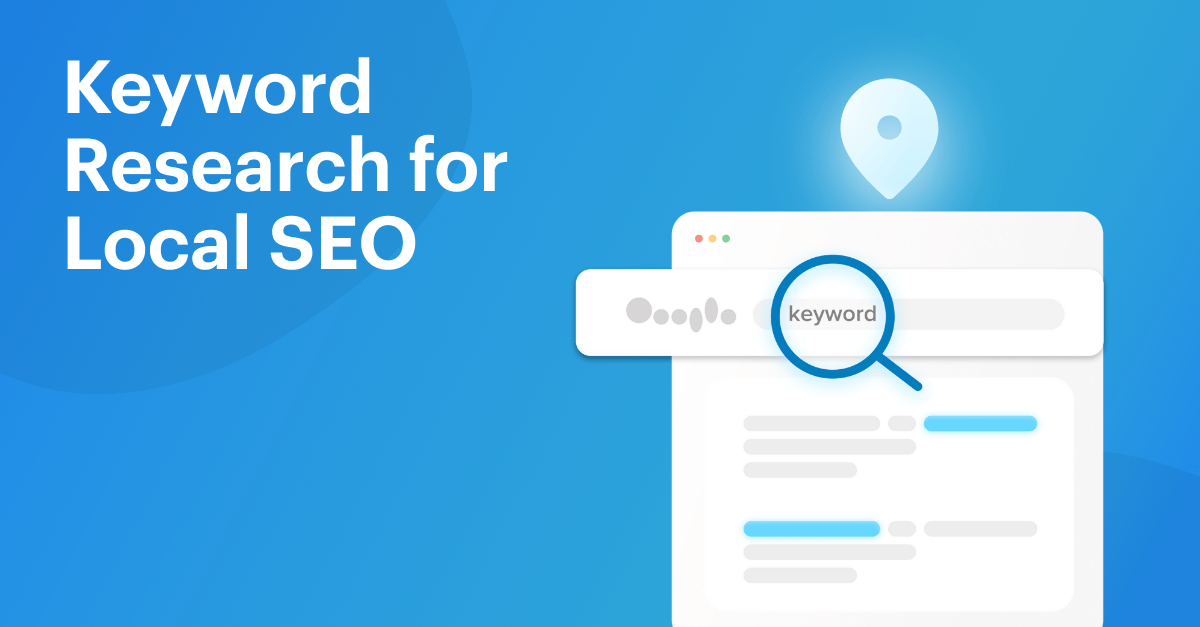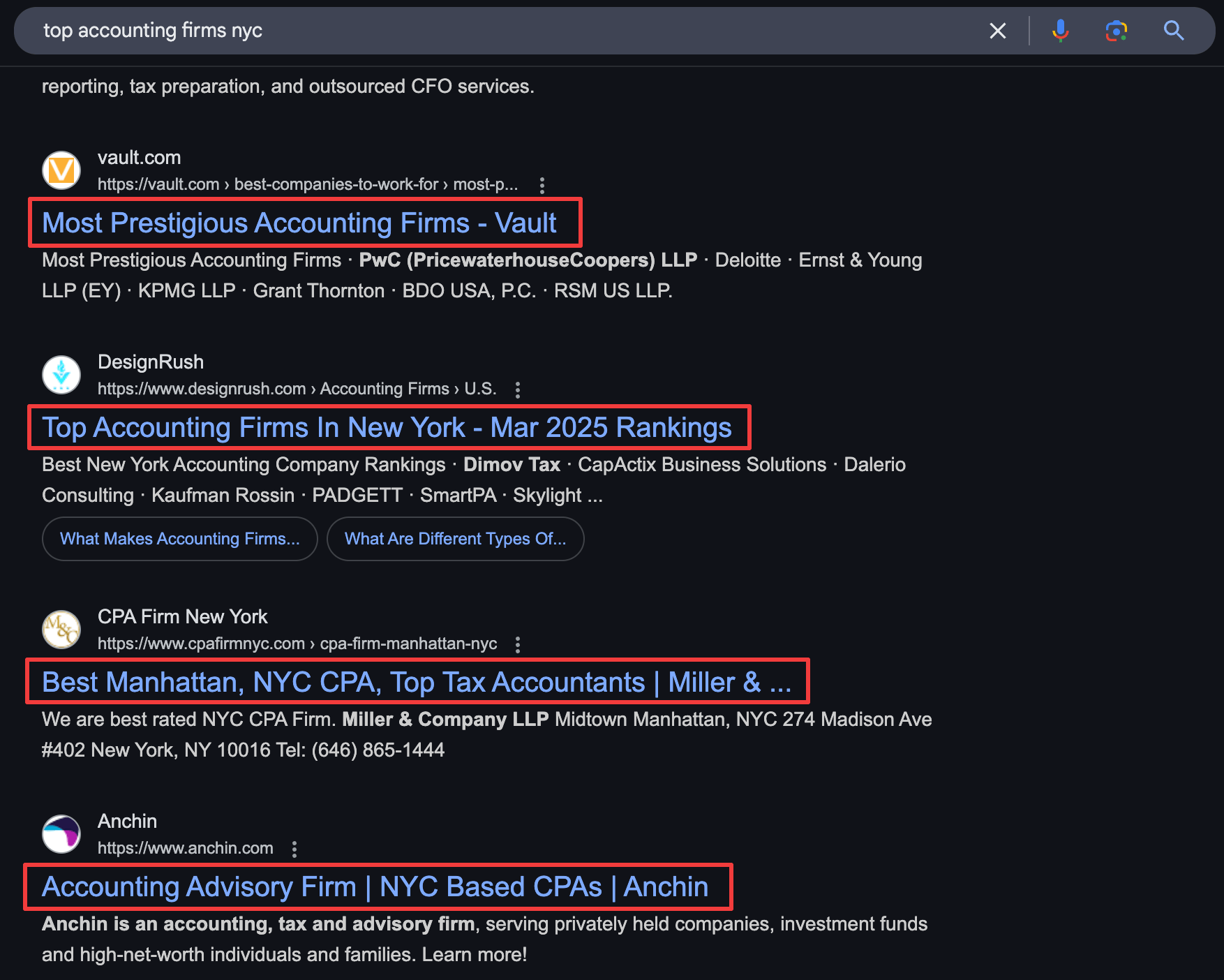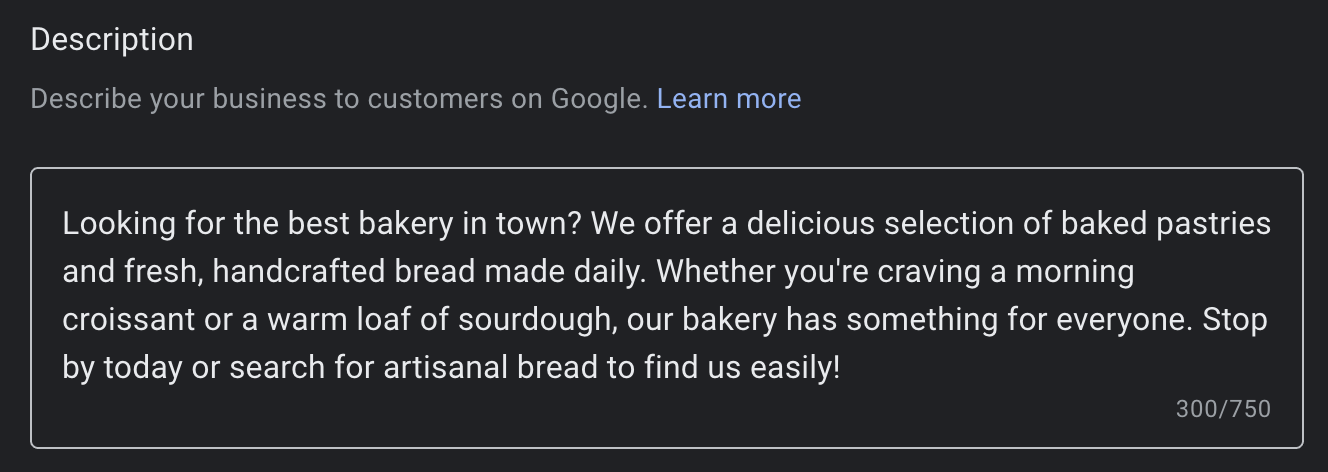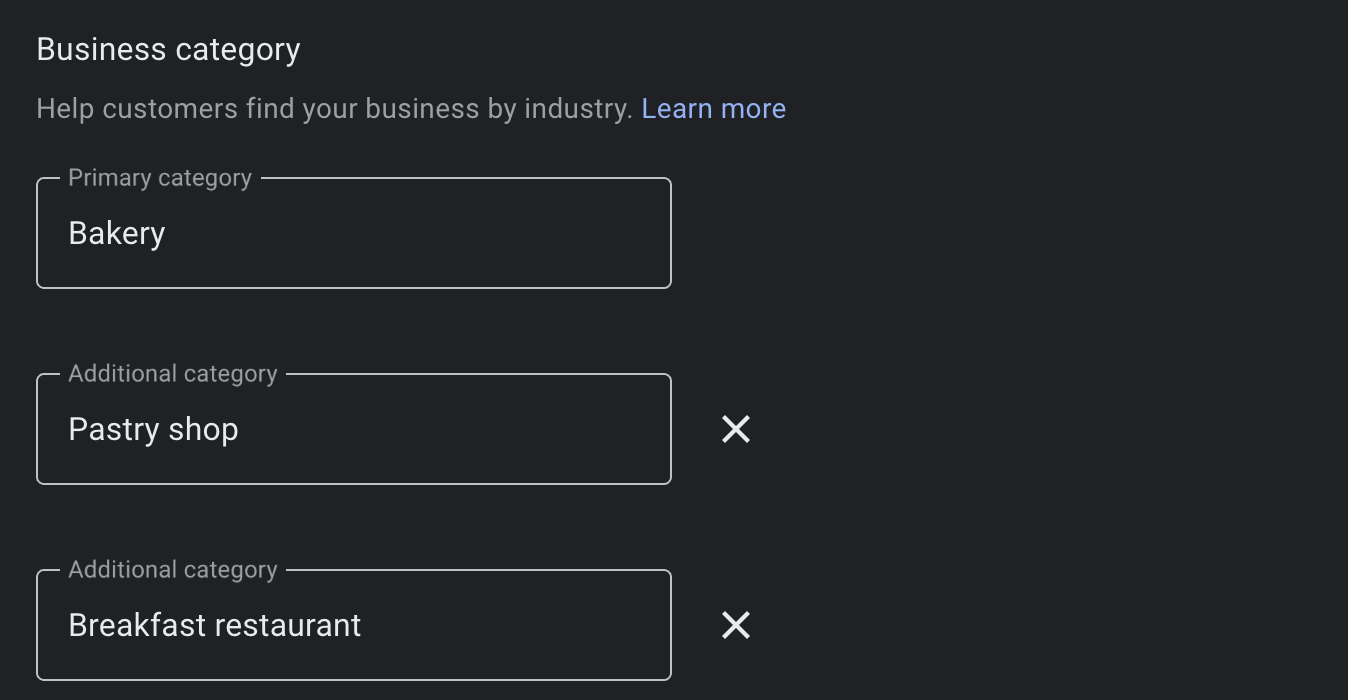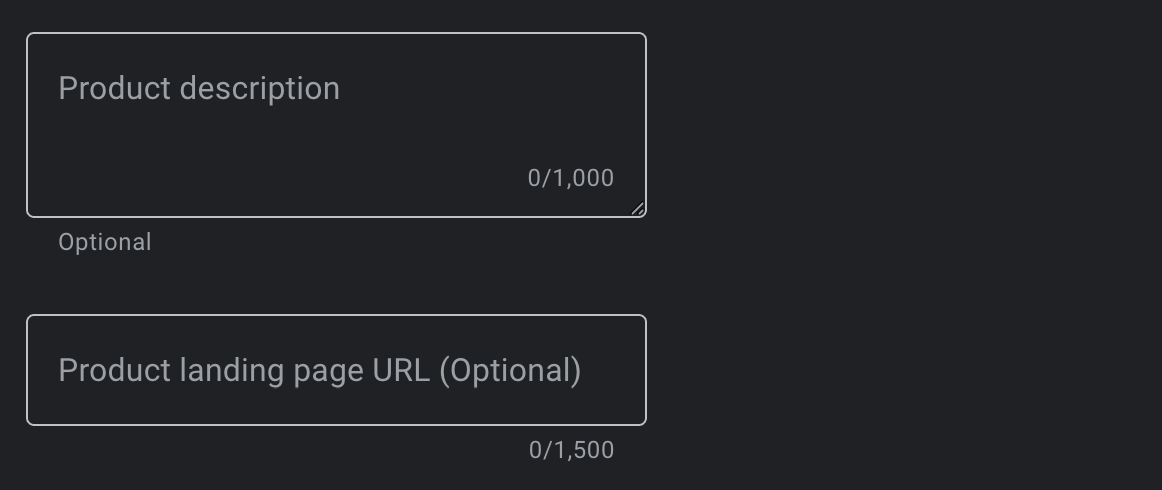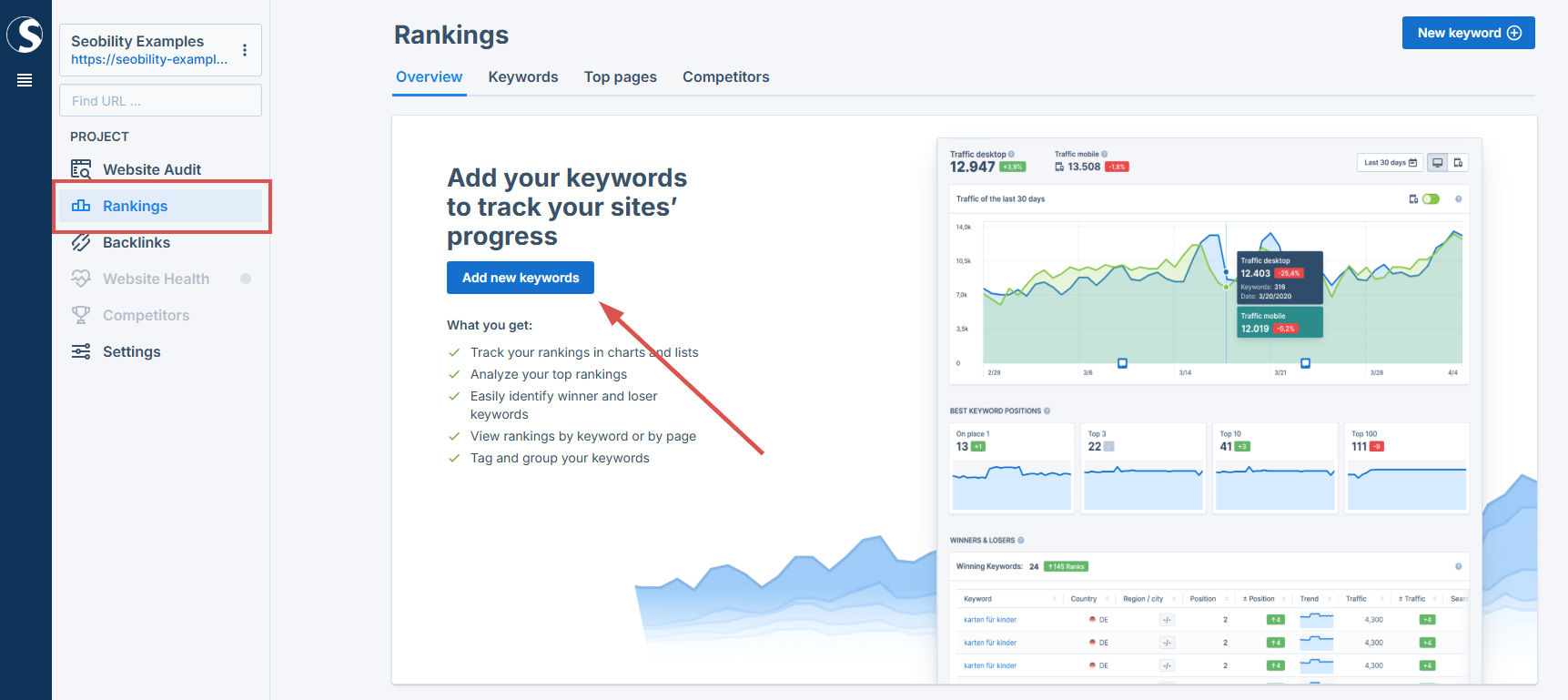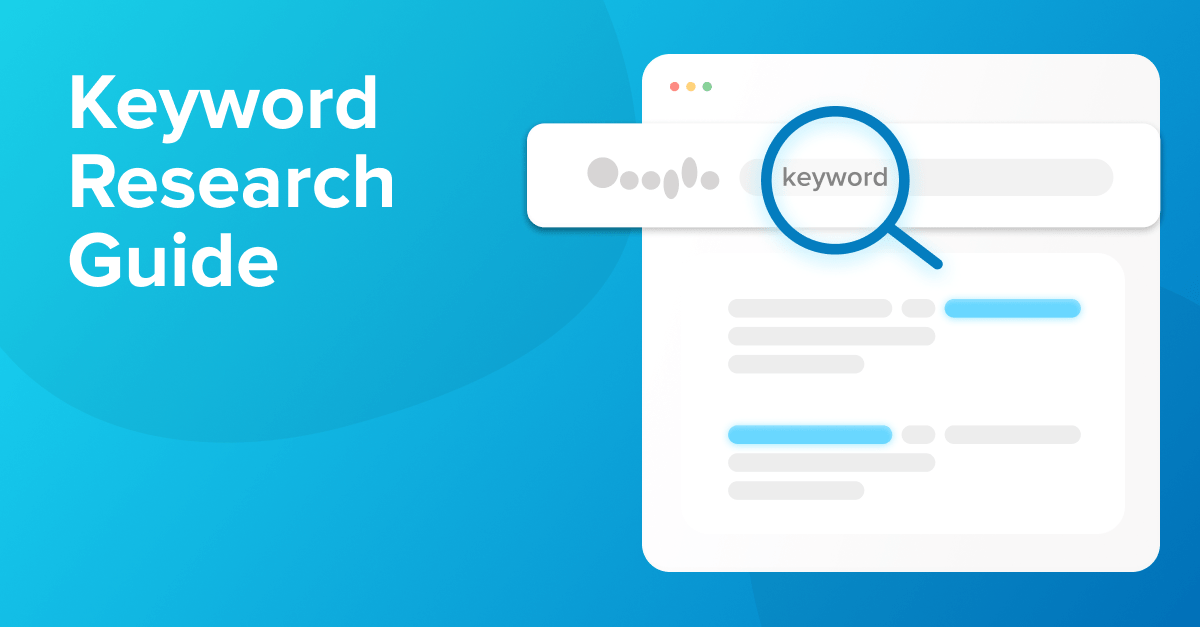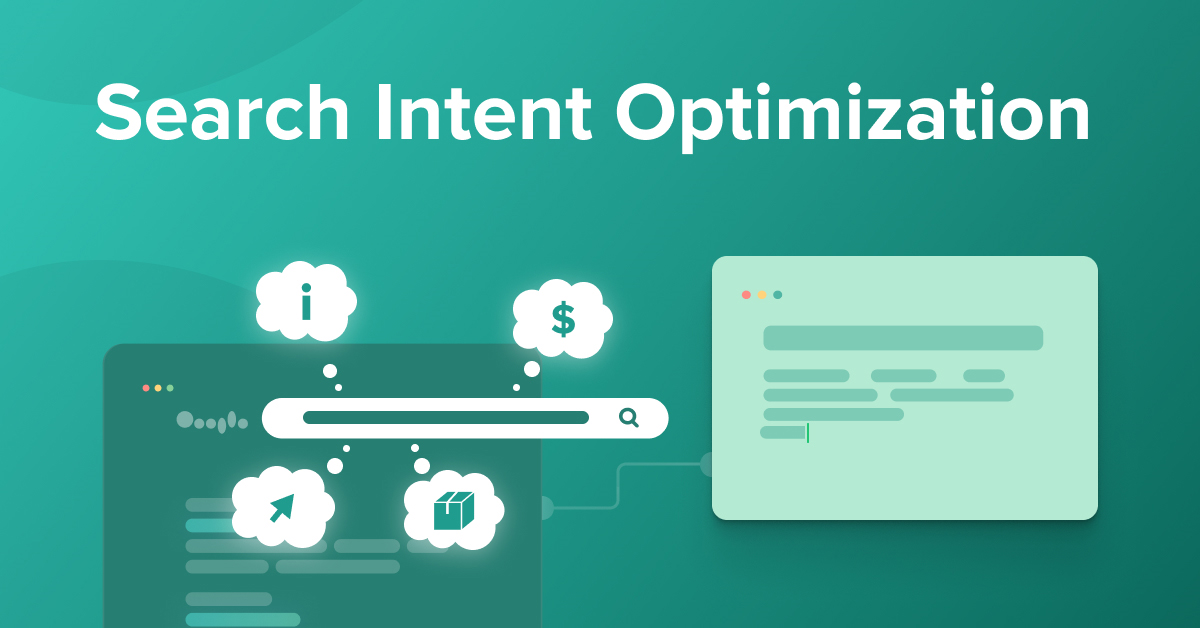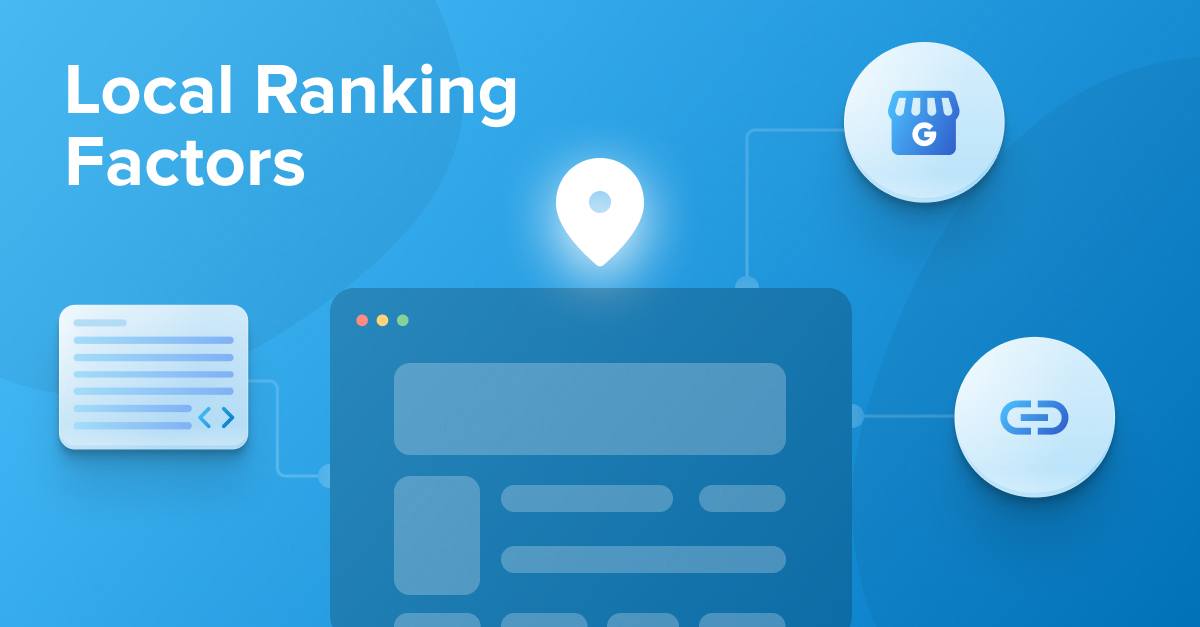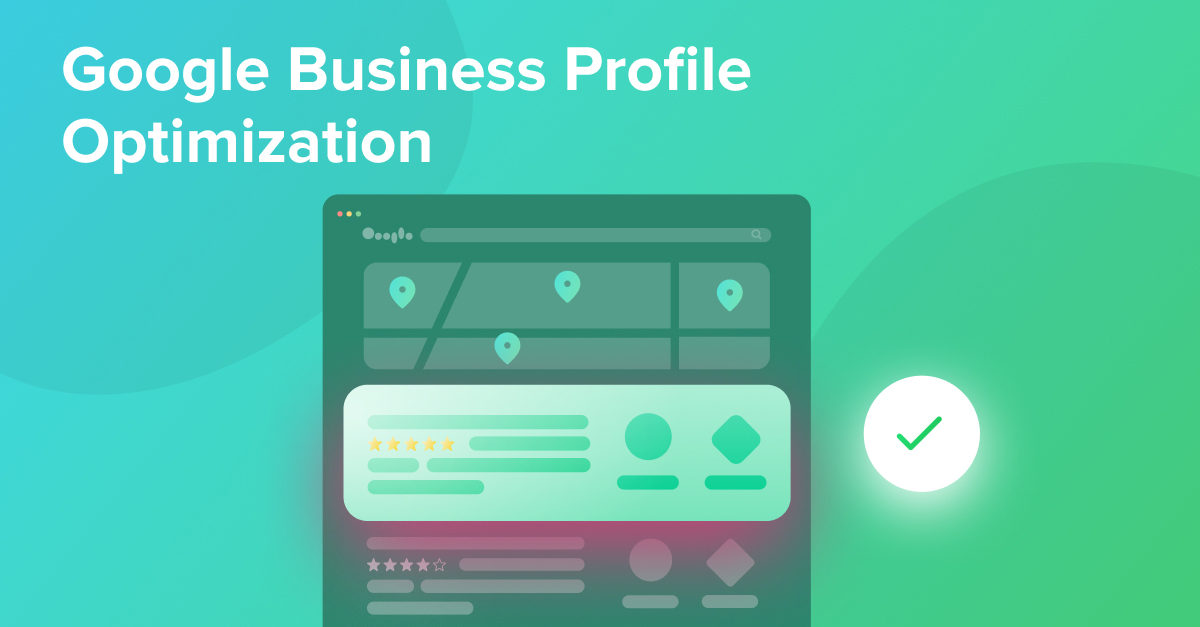Local keyword research is an integral part of local SEO. To outrank your competitors and attract (real) traffic to your local business, you need to find the right keywords to target.
If you’re wondering if local keyword research (or local SEO in general) is worth it in 2025, consider this: According to SOCI, 80% of US consumers use search engines on a weekly basis to find information about local businesses. So effective local keyword research can give you a serious advantage over competitors.
This raises the question: How do you perform local SEO keyword research?
In this guide, we’ll explain the five key steps of keyword research for local SEO. We’ll also show you how Seobility’s free Keyword Research Tool can help you with this.
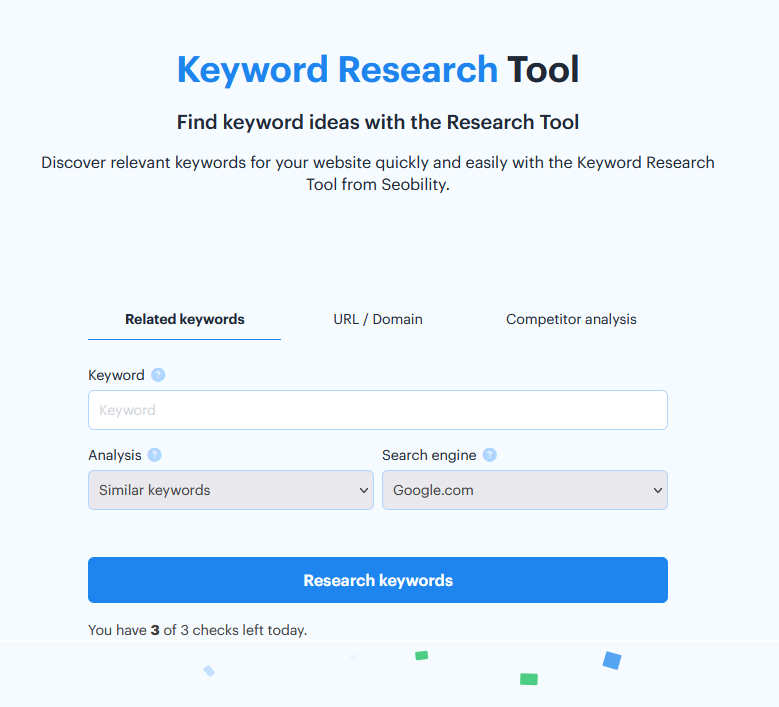
We’ll begin by looking at the basics of local SEO keyword research. If you’re already familiar with the basics, you can skip to the hands-on section.
Please note that this article focuses on traditional keyword research for local SEO. However, new AI features and tools are currently changing the way online searches work significantly. For this reason, we’ve included an outlook on the potential impact of AI search on keyword research at the end of the article.
What is local SEO keyword research?
Local SEO keyword research is the process of finding keywords people use when searching for products, services, and other conveniences in their local area.
When users search for local services, they often use location-specific terms, such as “car repair shops in Berlin” or “affordable photographers in Tokyo.” One example is the Google search result below, where the local keywords consist of the seed keyword (“IT support services”), keyword modifier (“in”), and location (“New York”).
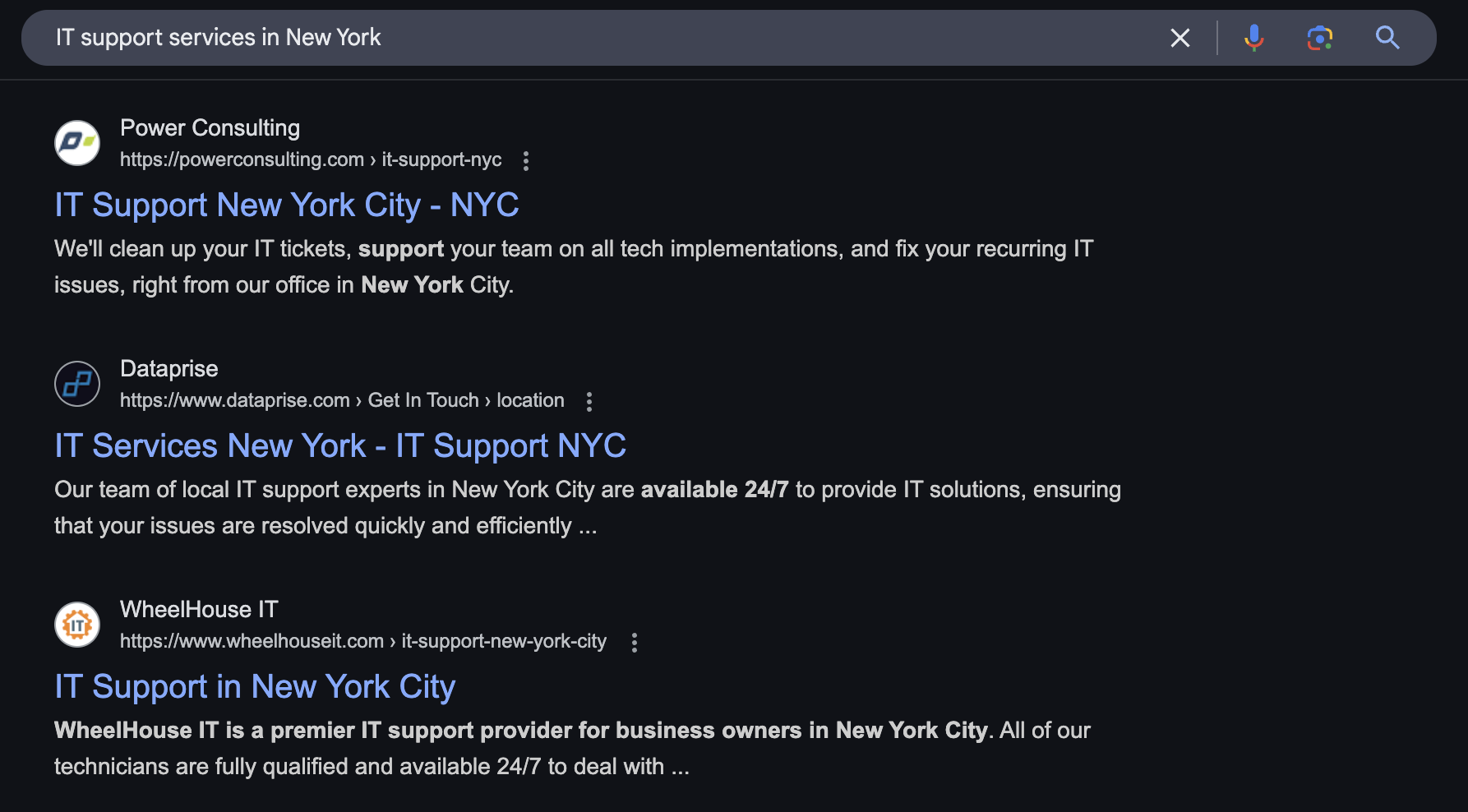
When talking about local search, it’s also important to understand the difference between explicit and implicit search.
Explicit search is when the user consciously gives the search a specific geographic focus with terms like “in New York.” The search shown above, “IT support services in New York,” is an example of explicit search.
Implicit search, on the other hand, is when the user doesn’t specify a location, but still intends to find something nearby. An example might include a search like “barber shops”: While no location is mentioned, it’s clear that nearly all users searching for “barber shops” are primarily interested in barbers in their own city, not in another country or on another continent. Here’s an example of implicit search:
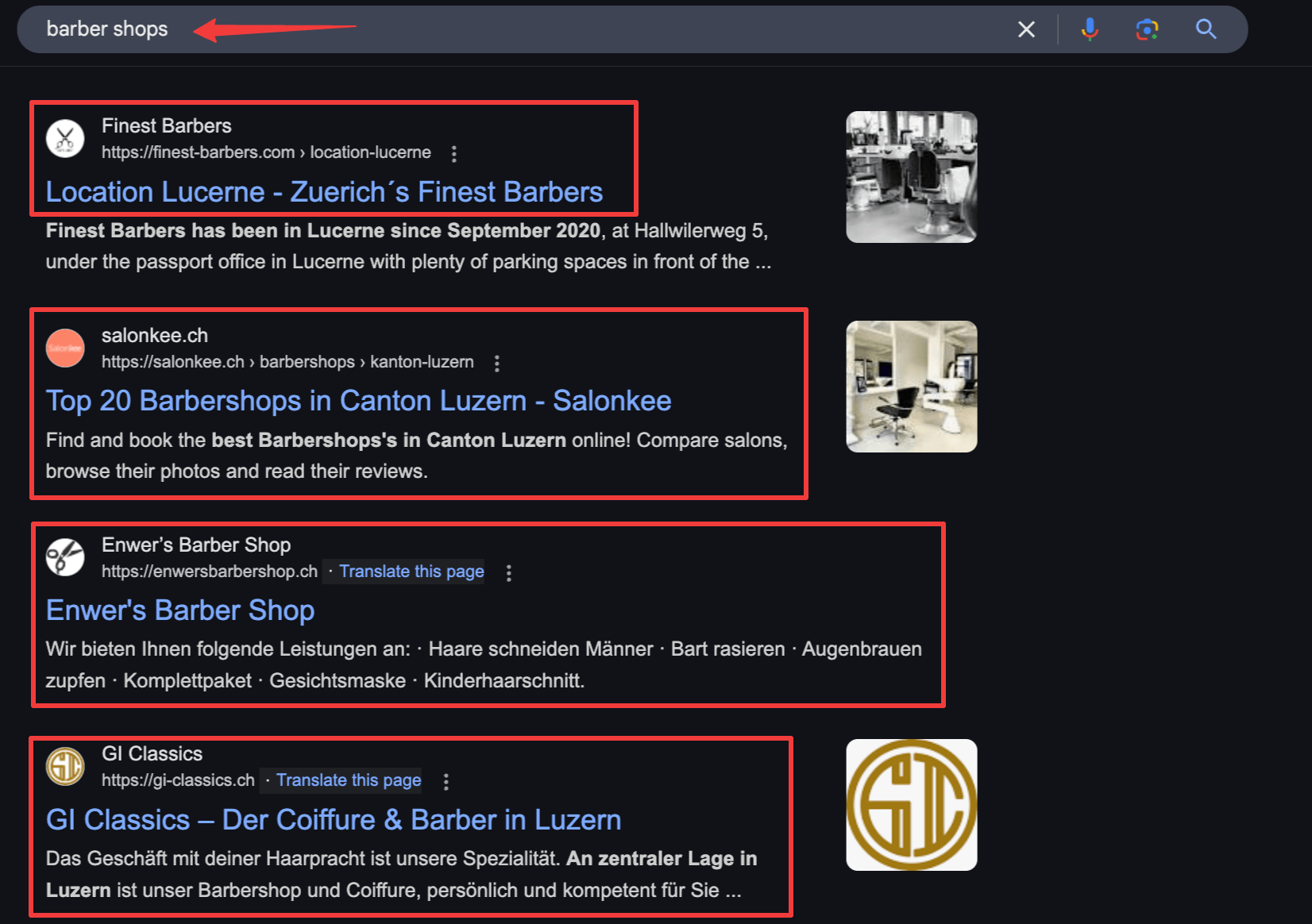
Just as there are explicit and implicit searches, there are also explicit (or local) keywords and implicit (general) keywords that imply a local search intent. When you search for local keywords to target, start by looking for explicit keywords, as they’re easier to identify.
By using factors like past search history, the user’s location, and the type of business being searched for, Google has gotten pretty good at determining local intent, regardless of whether the search is explicit or implicit.
This means that if you rank for explicit keywords and take care of other local SEO ranking factors, you’ll most likely rank for the implicit keywords as well.
However, depending on the size of your town or city, there might not be enough search volume for explicit keywords. In that case, you need to broaden your search to include implicit keywords. The best practices for doing keyword research for implicit and explicit keywords differ in some ways, so we’ll go through each of them in the hands-on section.
Why local keyword research is important
When local keyword research is done correctly, it can yield incredible results for your small business. The benefits include:
Better overall search visibility: While your Google Business Profile is important for positioning your business in the Local Pack, local SEO goes beyond that. Local keyword research helps improve your overall search visibility by promoting it in organic local search results. For example, if you own a renovation company in Madrid, your website can rank for keywords like “Renovation service in Madrid” or “home remodelling service near me”:
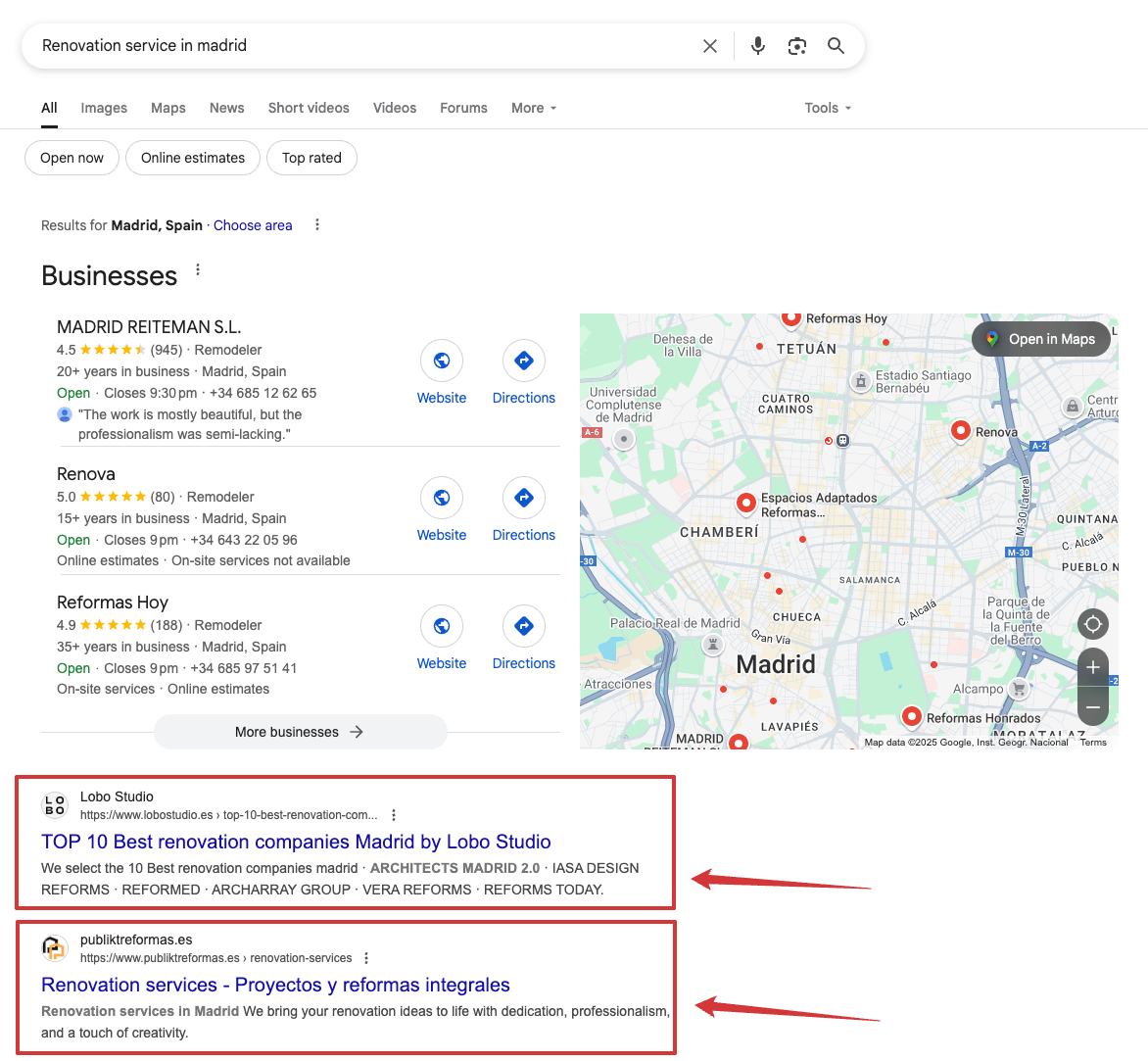
- Deeper understanding of what people search for locally: Understanding what local search queries your customers are making improves your local SEO and your overall understanding of your customers. You might find completely new areas to target with your business.
- Higher conversion rates: Local keyword research helps you find the right keywords to target, improving your conversion rate. For example, if you’ve previously only targeted keywords with informational intent, finding commercial intent keywords helps you find customers who are ready to buy.
- Stronger local authority: With the rise of AI tools and social media to search for local businesses, it’s easy to underestimate the importance of building your local authority through SEO. Despite these recent changes, 80% of consumers still think of Google as the primary channel for searching online, so building local authority remains important.
How to do local keyword research
Before we look at each step of local keyword research in more detail, let’s take a look at the overall process.
In its simplest form, local keyword research consists of four steps:
- Step 1: Make a list of potential keywords. Based on your business’s goals, create a list of potential keywords. Start by identifying your business’s core themes (such as “cleaning service”) and combining them with keyword and location modifiers.
- Step 2: Validate local keywords to target. By itself, a list of keywords isn’t enough to succeed with local SEO. You need to validate the list using keyword research tools, Google’s free tools and resources, or by doing a competitor analysis.
- Step 3: Look at local metrics and prioritize keywords. Local keyword metrics, such as the competition level, search volume, cost per click (CPC), and search intent, help you decide which keywords are worth your effort.
- Step 4: Add keywords to your website. In SEO, the process of keyword mapping involves adding keywords to the appropriate pages, meta descriptions, URLs, and body content. If you don’t have a page for a specific keyword, you can create a new product page, landing page, or blog page for it.
- Step 5: Add keywords to your Google Business Profile. To improve your Google Business Profile rankings, you can add local keywords to the business description, categories, Q&A sections, and service and product pages.
After taking these five steps, it’s important to track your local keywords. And if you operate in multiple locations, you’ll need to conduct additional research for each location. We’ll touch on these topics after looking at each of the five steps in detail.
Step 1: Make a List of Potential Keywords
Your keyword research for local SEO should start with a simple question: What am I trying to optimize for? As a local business owner, you know your goals best.
A good place to start is to prepare a list of potential keywords to target. You can begin the process by simply identifying your business’s seed keywords.
Discover your seed keywords
Think of seed keywords as the key areas your local business revolves around. For example, if you run a business selling computers, your seed keywords could be “Mac laptops,” “Windows laptops,” and “desktop computers.”
Seed keywords are short-tail keywords (a maximum of three words) that are often high-volume and highly competitive. After finding the seed keywords, the aim is to combine them with keyword modifiers and local modifiers.
To identify your seed keywords, you can do the following:
- Brainstorm: Start listing your business’s core themes. Think of questions such as who the primary target groups for your products or services are, what these people’s needs are, and how they search for what you’re offering.
- Talk to customers: You can review previous customer conversations and have new ones to identify customers’ problems that need to be solved. For example, if your local business sells laptops and your customers constantly complain about the need to fix their laptops, one of your seed keywords could be “laptop maintenance.”
- Look at Google Search Console data: If your website already has traffic and Google Search Console is set up, analyze your search result data to find seed keywords. In the “Search results” tab, go to the “Queries” section and sort by “Clicks.” That will show you the queries that are driving the most organic search traffic to your site. These queries can give you great ideas for other keywords to target.
- Read forums and social media: Forums such as Reddit and Quora and social media platforms can help you find common topics and phrases people are using to discuss products and services similar to yours.
- Read customer reviews: Customer reviews can be a good source of keywords. For example, if a customer mentions that your bakery offers “the best pastries in town,” it could be a potential keyword to target.
Add location modifiers to your seed keywords
Once you have identified your seed keywords, you can continue by adding location modifiers. Location modifiers are terms that indicate local intent. Consumers often search for local businesses using additional terms like “in New York,” “nearby,” or “near me.”
To add a location modifier, combine your seed keyword and the location or city where you operate. For example:
- “Plumbing services in Chicago”
- “Construction companies in Zurich”
- “Libraries in Lisbon”
This will let keyword research tools validate whether there is demand for the keyword and suggest related keyword variations.
Step 2: Validate Local Keywords to Target
You might have a list of potential keywords, but you don’t have proof that your customers are searching for them. You still need to validate your keywords.
To do this, you can use a number of strategies, including keyword research tools, Google’s free tools and resources, or a competitor analysis. Below, we’ve broken down each of these options.
Use keyword research tools
Keyword research tools can be used to find both explicit and implicit keywords. To validate your keywords, start by entering them into Seobility’s Keyword Research Tool. In our example, we’ll use the keyword “Best accounting services in New York”:
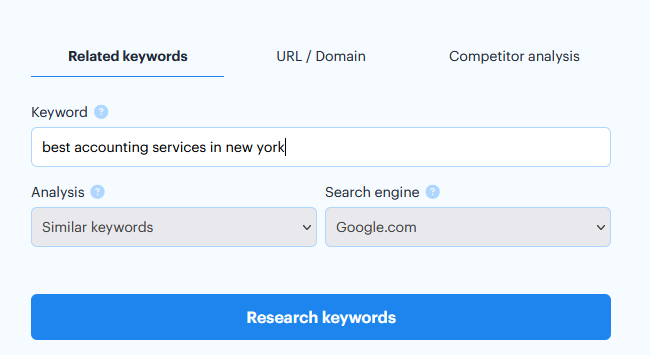
After clicking on the “Keyword Research” button, you will see a list of keyword ideas pop up:
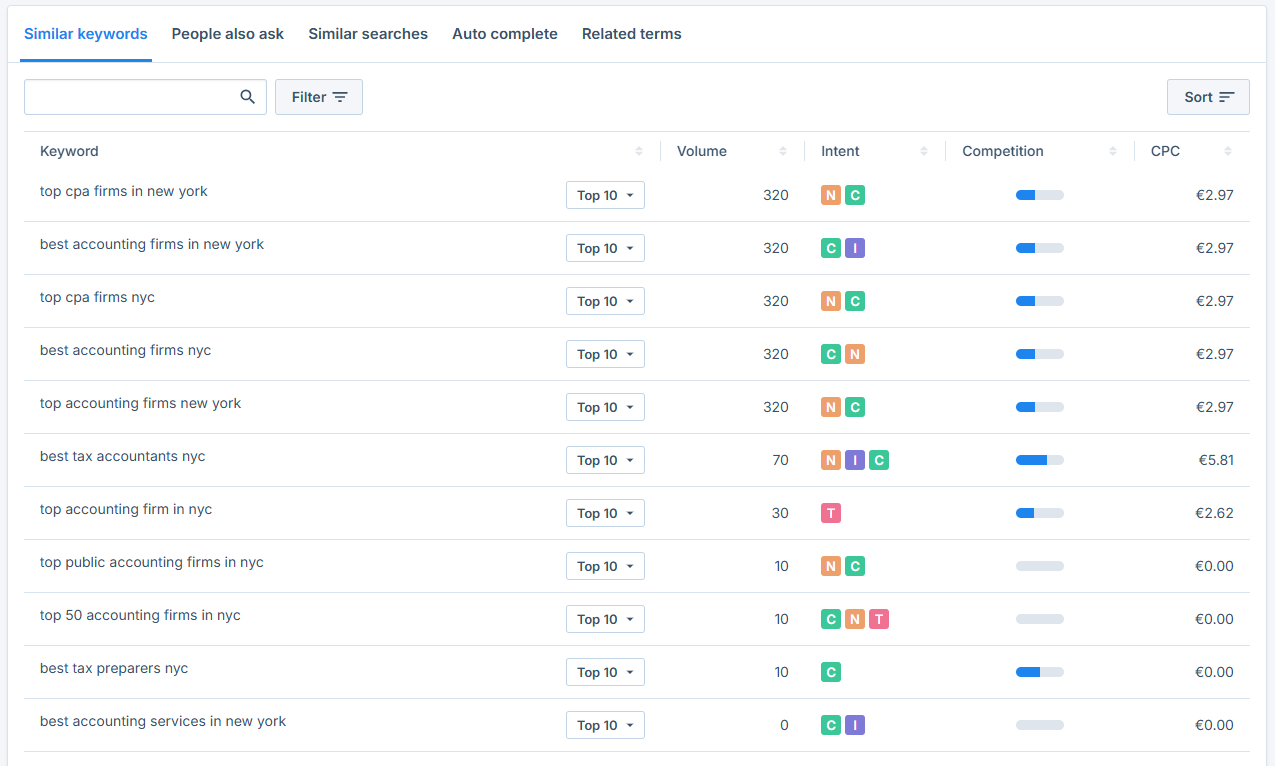
The keyword ideas are divided into different tabs, including Google’s “People also ask” and “Similar searches” (more on that later).
The results may include many slightly different variations of similar keywords. For example, “best accounting firms NYC,” “top accounting firms NYC,” and “best accounting firms in New York.” While these are different keywords, they all target the same search intent (people looking for accounting firms in New York).
These keywords also generally have the same SERP results. For example, if we search for both “best accounting firms NYC” and “top accounting firms NYC,” we can see that the search results are the same.
As a general rule, keywords that have the same SERP results should be grouped together. Google is smart enough to determine the search intent for keyword variations, so you don’t have to create separate pages or articles for them.
If you live in a less populous area or small town, the Keyword Research Tool might not give you many results when you enter your seed keyword and location modifier. For example, when we added the keyword “plumbing services in Hernando County,” we only got four results:
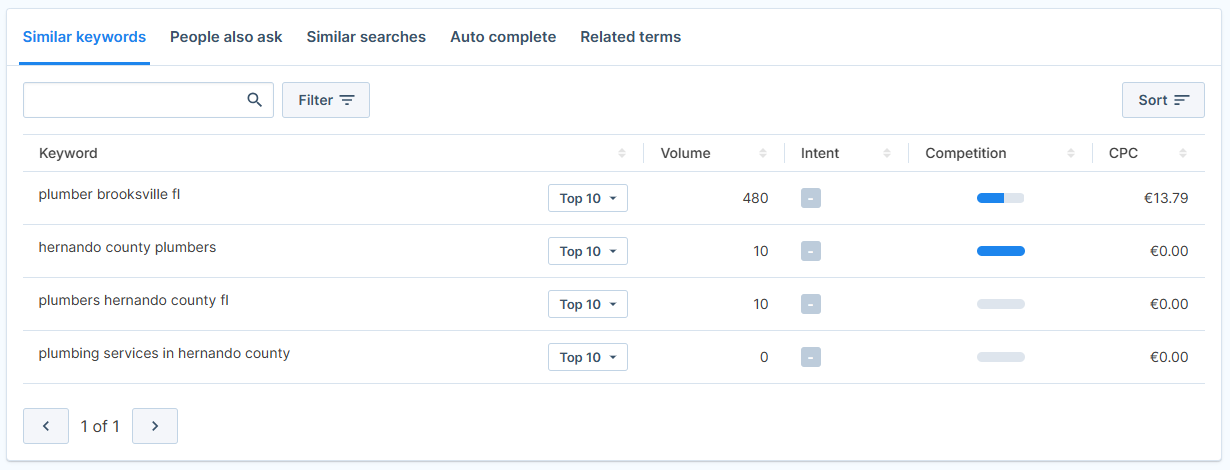
When this happens, it doesn’t necessarily mean people aren’t searching for services in your area. It may just mean they’re using implicit keywords, or that the search volume is low. In these cases, finding implicit keywords is another way to validate local queries to target.
However, if you try to look up implicit keywords in a keyword research tool, the estimates will apply to the entire country, or even the whole world. For example, we typed in “plumbers near me,” and the search volume shows over a million search queries per month for each keyword:

For this reason, Google Keyword Planner is the best tool for validating implicit keywords, as it allows filtering by more specific locations. We’ll cover how to use it next.
Use Google Keyword Planner
Google Keyword Planner is a great option for validating implicit local searches.
To use Google Keyword Planner, you need to have your Google Ads account set up. In the dashboard, type in your potential keywords. Since Google Keyword Planner uses your location to spot keyword opportunities, typing in your seed keyword is often enough.
We’ll use the keyword “barber shops” as an example. After typing it in, Google suggests several keyword ideas:
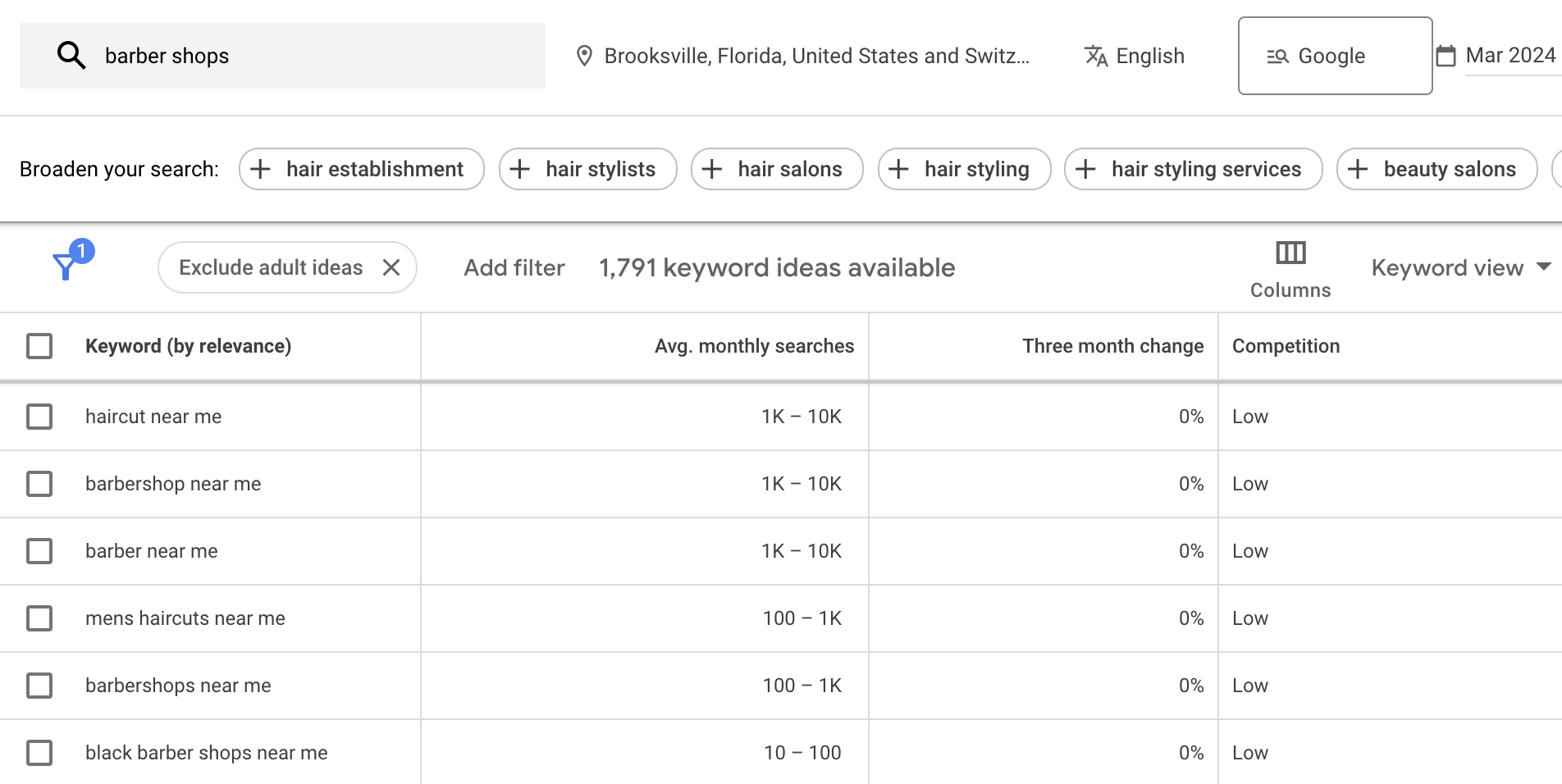
As you can see, Google Keyword Planner is capable of spotting local search trends. In the above example, you can see implicit local keywords like “barbershops near me” and “haircut near me”.
From here, we’ll pick all the relevant keywords for our local business. By clicking on “Add keyword to create plan,” you can save these keywords for later analysis or for creating ad campaigns.

Alternatively, you can enter your website URL into Google Keyword Planner to discover new keyword opportunities:
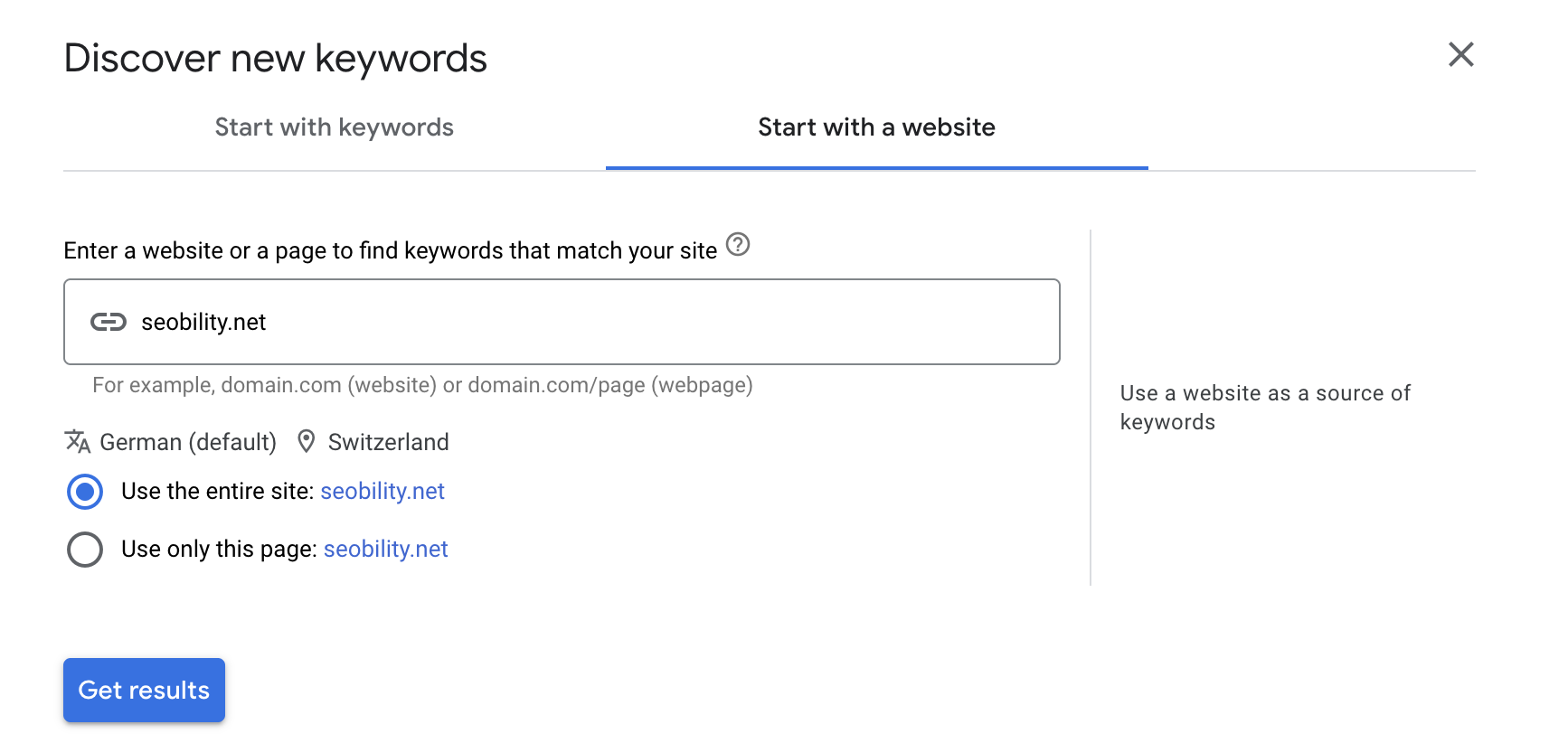
Use Google Search Console
If your website already has some traffic, you can use Google Search Console (GSC) to validate your keywords and discover new opportunities.
Head to the “Search results” tab on your GSC dashboard to get started. You’ll see a search performance report displaying total clicks, impressions, CTR, and average position.
Scroll down to the “Queries” section and sort by “Clicks” to see which queries drive the most traffic to your website.

These terms are your highest-performing keywords, and you can use them to discover more keyword opportunities. You can make a list of these keywords to use for further analysis in Seobility’s Keyword Research Tool.
Type in your keyword on the “Keyword” tab and select one of the filters in the “Analysis” tab, such as “Similar keywords.” You can browse through all the tabs to find new ideas.
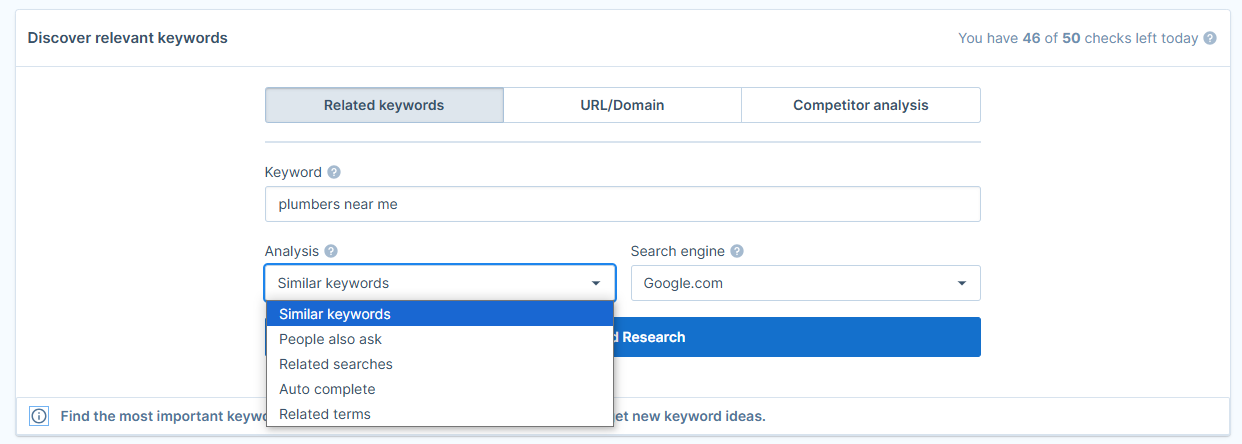
Use Google Trends
Google Trends is a free tool that reveals trending search queries and shows their popularity over time. To use it, type in your seed keyword, which in our example is “home renovation.”
Narrow down the search by adding your country:

Now you have a few different sections to analyze. You can scroll down to the “Interest by region” section and narrow it down by “City” to see more local trends.
The other two sections to look at are the “Related topics” and “Related queries.”
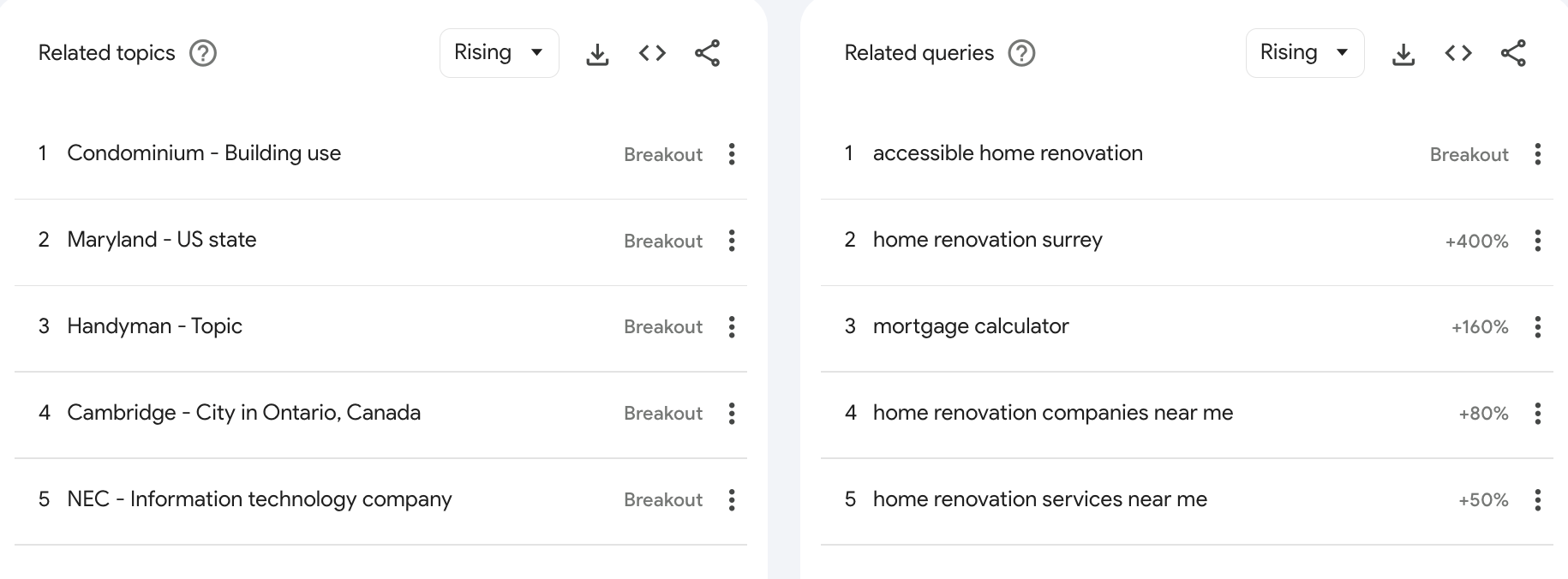
These sections are great for discovering trending topics and queries related to your keyword.
Google Trends works best for general keywords, but it often doesn’t show much data for long-tail keywords. For this reason, it’s best used for idea generation rather than precise keyword research.
You can add the keywords you discovered from Google Trends to your keyword research tool for further analysis.
Use the “People also search” and “People also ask” tabs
Google’s “People also search” and “People also ask” tabs provide additional local keyword ideas for your website and Google Business Profile.
To find the “People also search” section, type your seed keyword into Google and scroll to the bottom. You will see a list of searches related to your seed keyword:
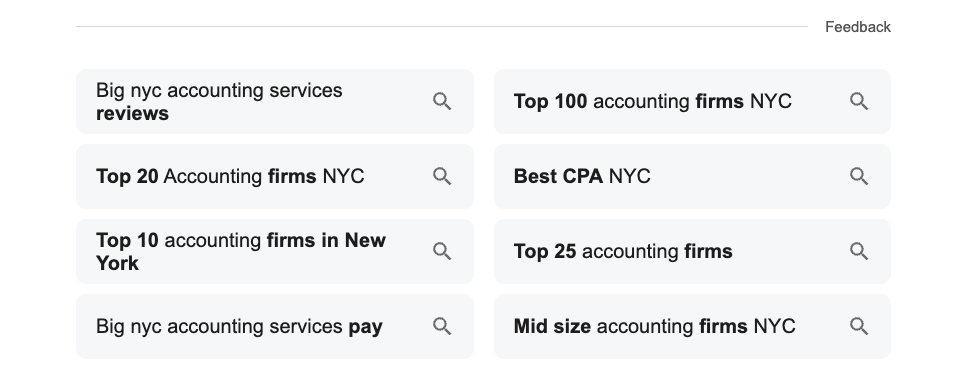
The SERP also contains a section called “People also ask” that has related questions:
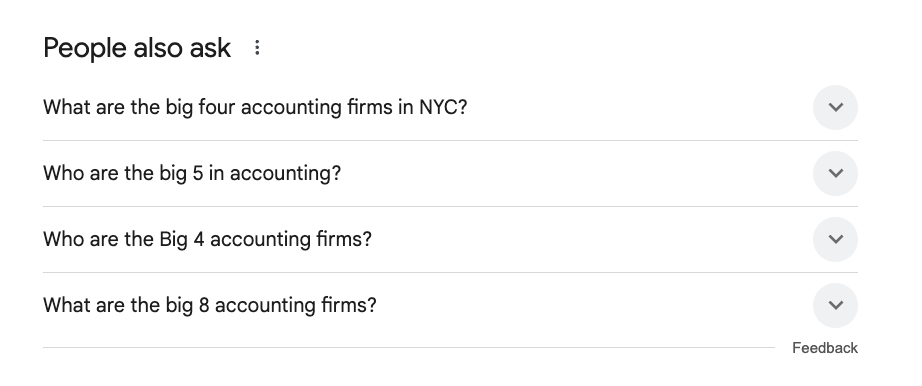
If a question is in this section, it means many people are searching for it, which can help you validate your existing keywords.
You don’t have to use Google to find these keywords. In Seobility’s Keyword Research tool, select the “People also ask” and “Similar searches” tabs to find this data:

Do a competitor analysis
Another way to validate your keywords and find new ones is to do a competitor analysis. Competitor analysis will reveal what keywords your top competitors are targeting and how much traffic they’re getting from them.
To do this, use the “Competitor analysis” function of the Seobility Keyword Research Tool. Type in your domain and your main competitor. In the “Analysis” section, select “Gap” to find content gaps.
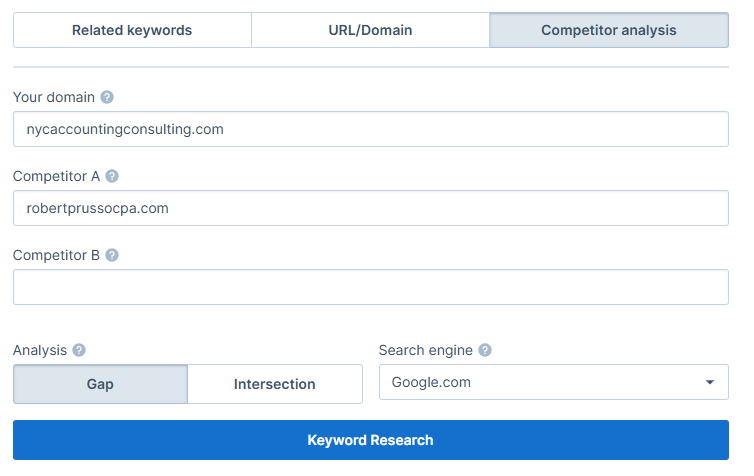
After you click the “Keyword Research” button, you will get a list of keywords your competitor ranks for, but you don’t. In our case, we found over 300 new keyword possibilities:
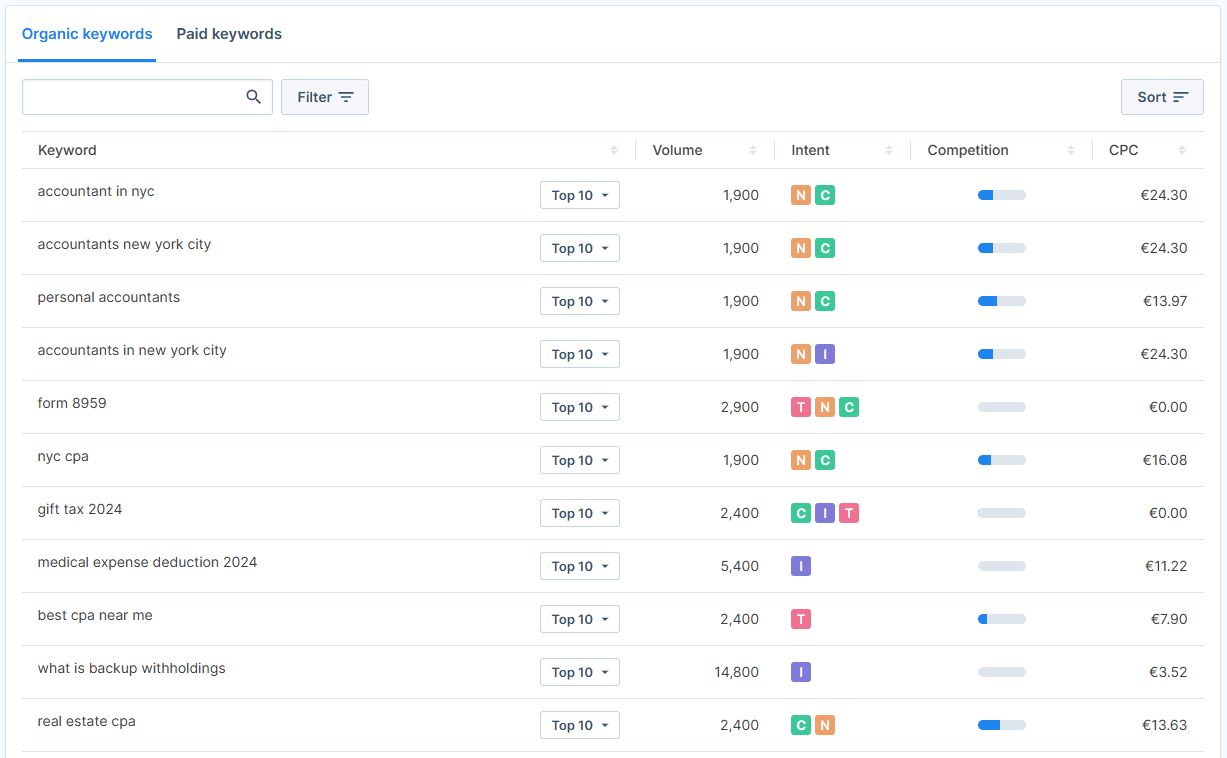
If the “Competitor analysis” tool doesn’t provide you with enough information, you can get even more data on your local competitors in the “URL/Domain” tab. Here you can see all of the keywords your competitors rank for. In this example, the page provided 1000+ additional keyword ideas:
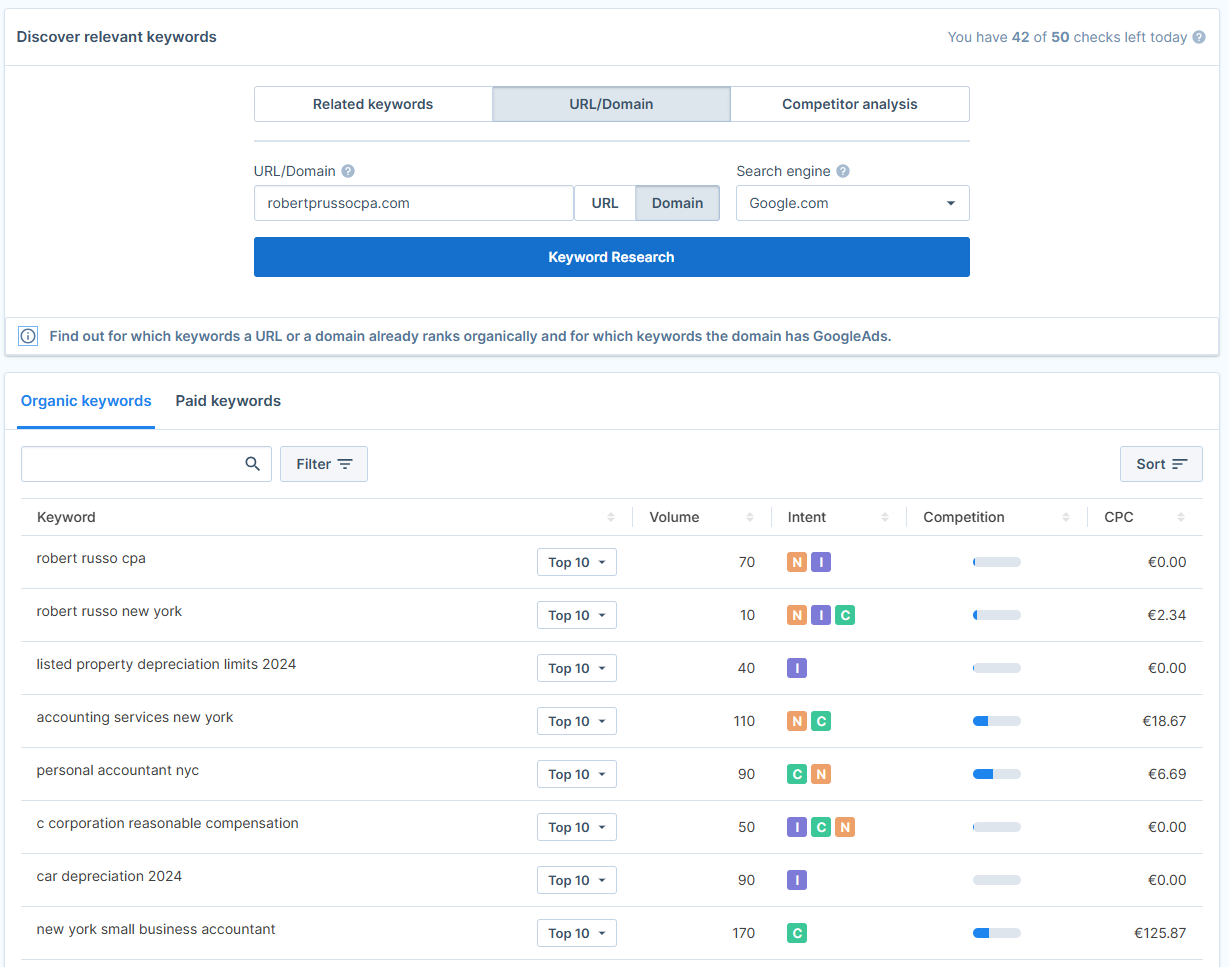
Step 3: Look At Local Metrics and Prioritize Keywords
After you have your list of validated local keywords, it’s time to look at the metrics and prioritize them. Not all keywords are equally important, so you should prioritize the ones that will gain traction and bring new customers to your business.
Let’s look at each of the key metrics you should look at.
Analyze search intent
We already touched on search intent, but let’s expand on it a bit more. People primarily search for information about a topic for four reasons: informational, navigational, commercial, and transactional.
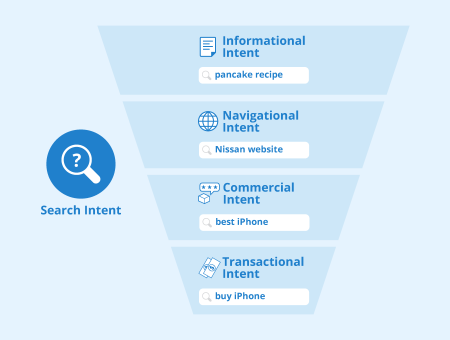
Most local SEO keywords fall under the commercial, navigational, and transactional categories since these keywords target people who are searching for a specific website, searching for products or services, or are ready to make a purchase.
With Seobility, you can see the search intent for each keyword. Type a keyword into the Keyword Research Tool and look for the “Intent” tab. Each keyword has its main search intent displayed, which helps you select keywords to target and what kind of content you need to create to rank for them. You can learn more about this in our guide on search intent optimization.
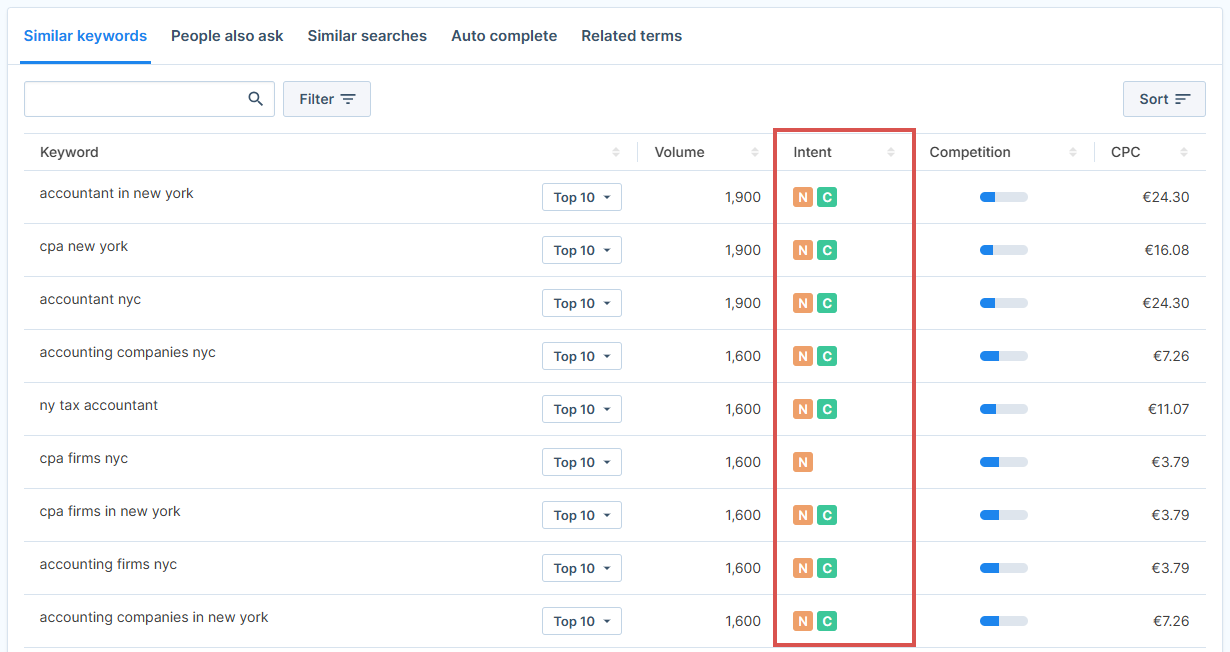
Look at the search volume
Search volume refers to the number of people searching for the keyword each month. The higher the search volume, the bigger the traffic opportunity is.
In the Keyword Research Tool, the “Volume” tab indicates the average number of searches per month.
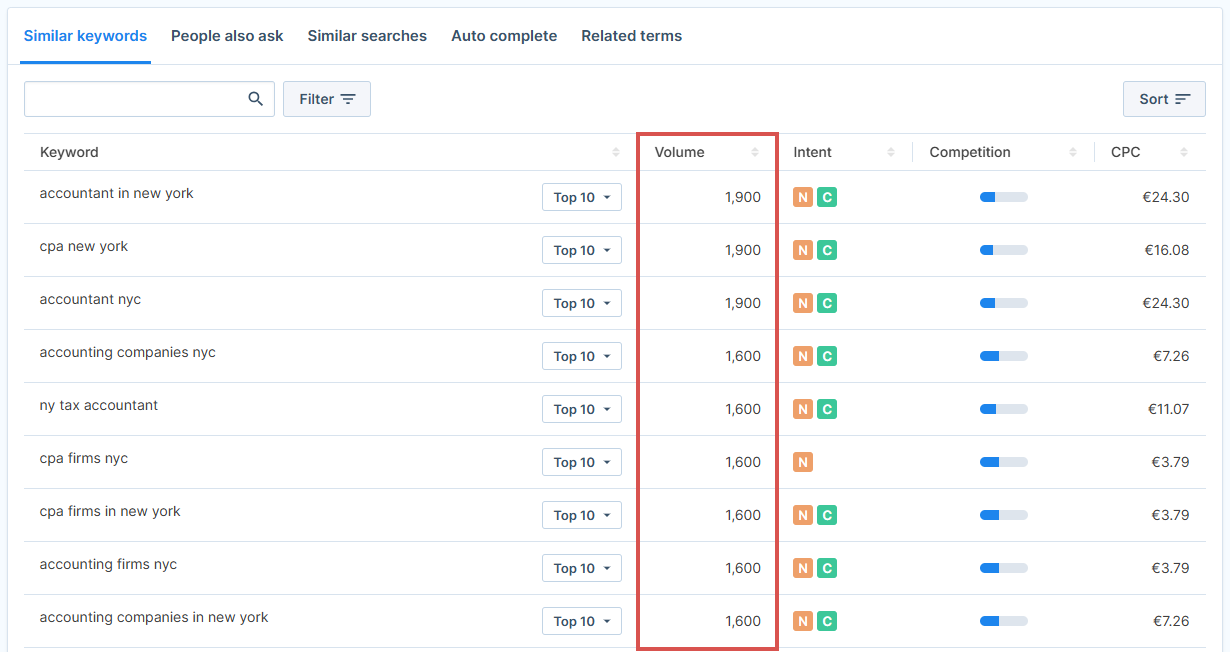
High search volume keywords are often more competitive, but not always. This is why it’s worth looking specifically at the level of competition.
Check competition levels
Seobility’s Keyword Research tool categorises the competition level as high, medium, or low. The competition level indicates how competitive a keyword is in Google Ads. However, it can also be an indicator of the general level of competition, including in organic search.
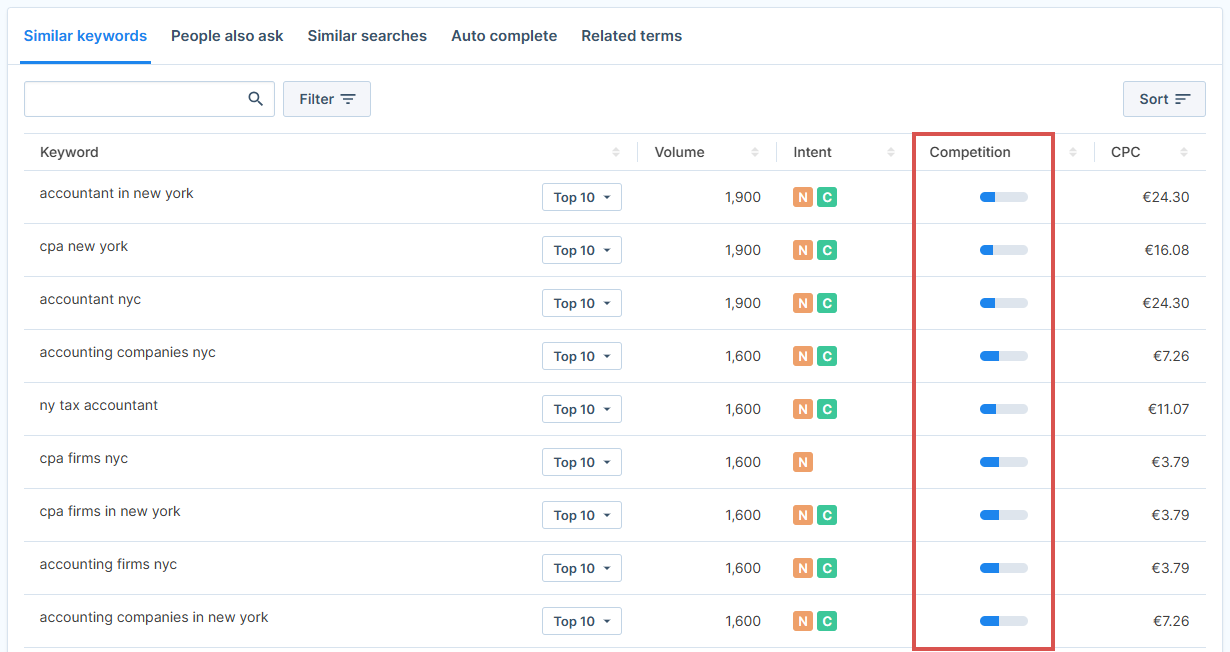
If you’re just starting out with local SEO, we recommend looking for keywords with low competition, as this gives you a better chance to rank for them.
Consider CPC for paid ads
Cost-per-click (CPC) is the estimated cost of a web ad in Google Ads. It’s the cost of a user clicking on your ad in the search results. Generally, a high CPC indicates strong commercial intent.
You can see the cost-per-click in the “CPC” tab in the Keyword Research Tool. The CPC is often highest for transactional, navigational, and commercial keywords.
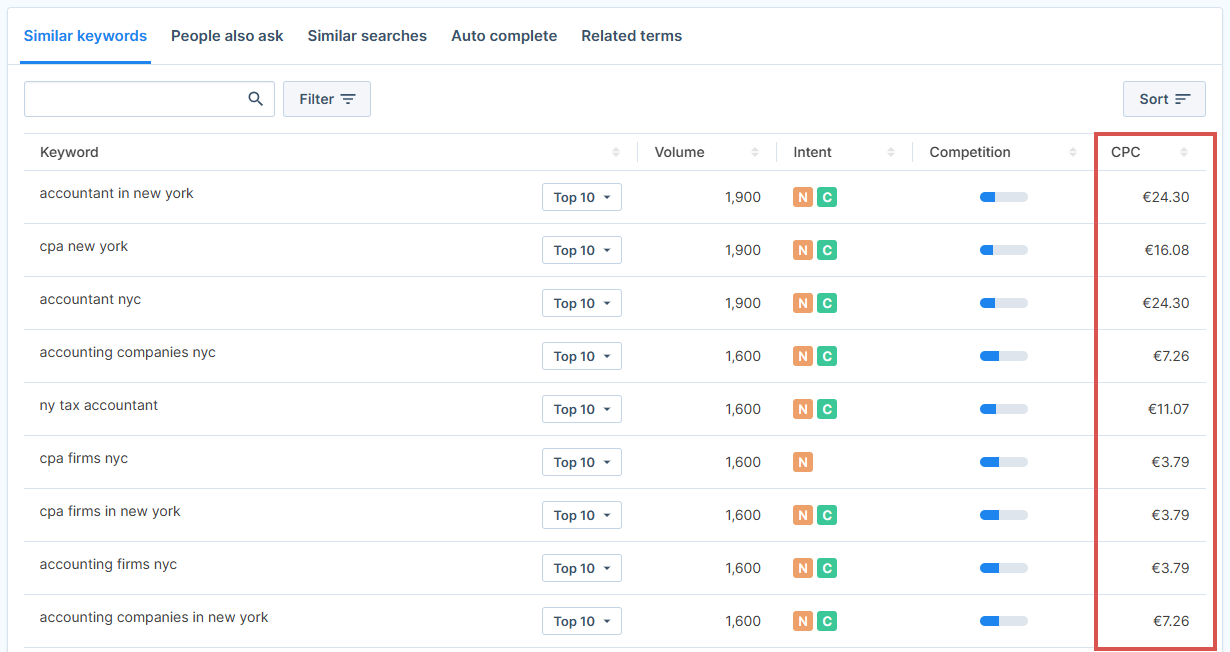
Check competitor backlinks
Backlinks are another local SEO ranking factor. If your competitors have a high number of backlinks for the local keywords you’re trying to rank for, they have an advantage over you.
For this reason, check the number of backlinks your competitors have for the keywords you’re targeting. To do this, click on the “Top 10” button in Seobility’s Keyword Research tool to see the top results for a specific keyword:
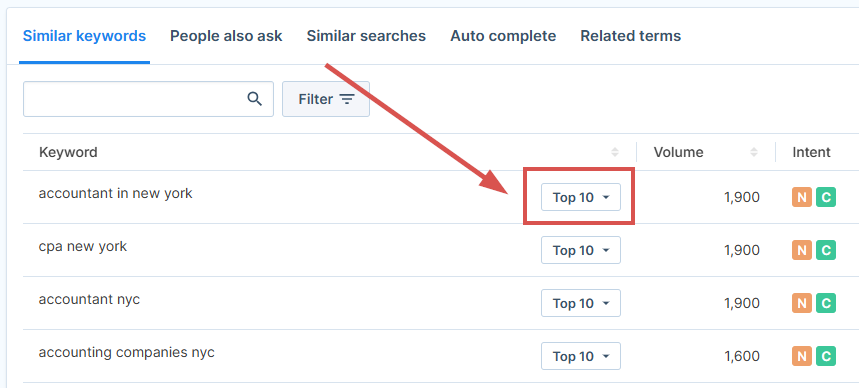
Once you click it, you’ll see the top 10 organic results for the keyword, including the number of backlinks each competitor has:
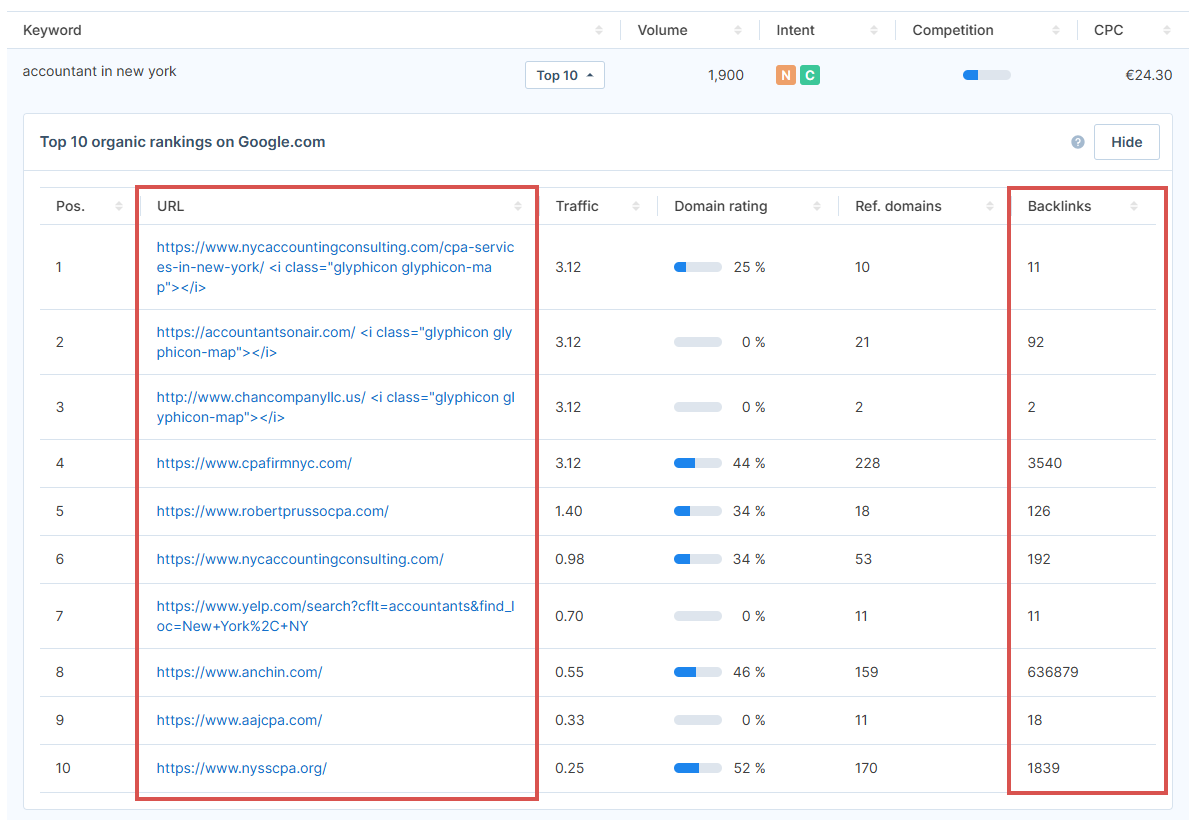
If you want to find out where your competitors’ backlinks come from, copy the site URL and paste it into Seobility’s Backlink Checker.
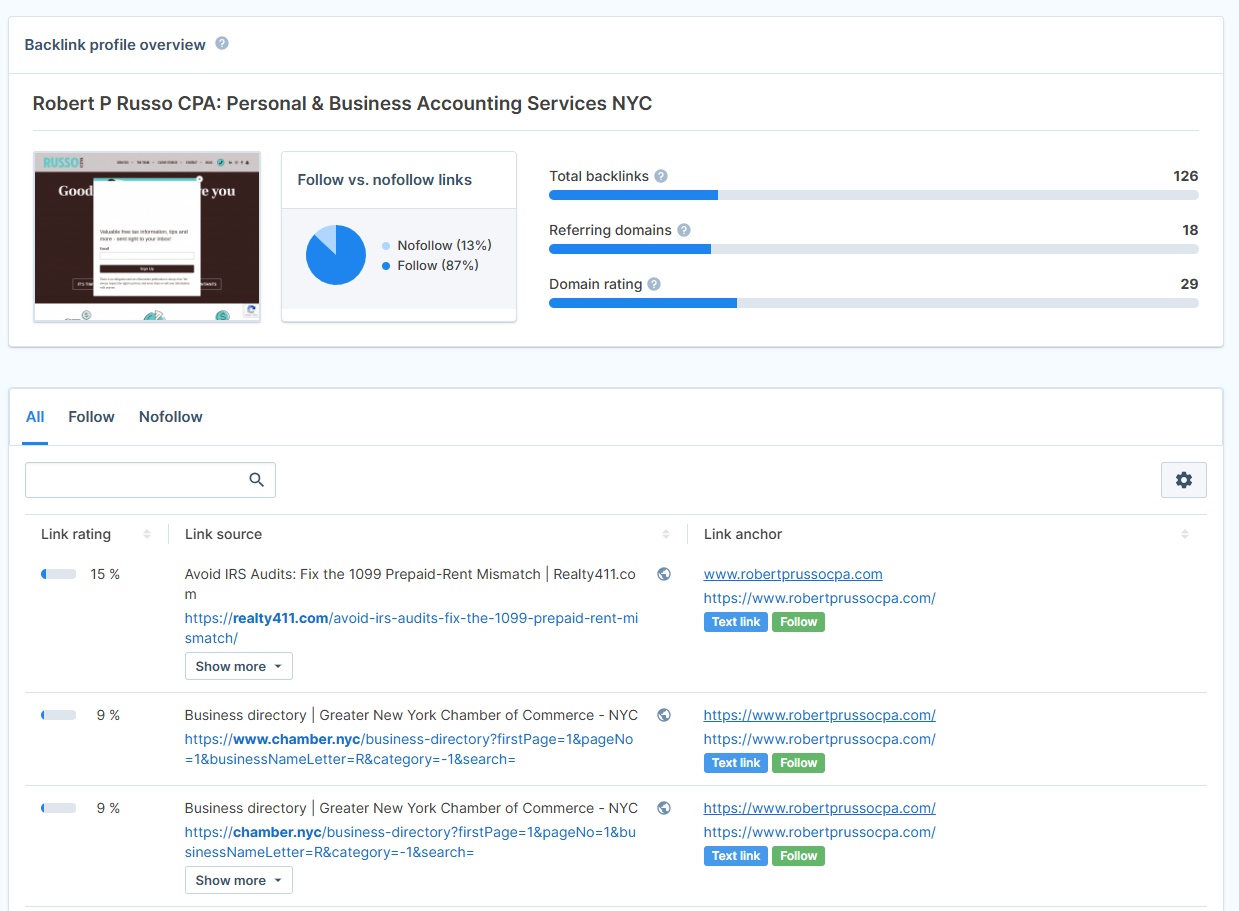
This can help you discover new backlink opportunities for your business. You may find that your competitors have gotten links from sources like local news, business directories, or industry blogs, which you can also target.
Tip: For more information on building backlinks for your business, read our local link building guide.
Step 4: Add Keywords To Your Website
Once you have validated and prioritized your local keywords, it’s time to map them out and create a content plan.
This involves four steps:
- Assign keywords to relevant pages: Your first step should be to check which keywords can be targeted on existing pages. A good rule of thumb is to use a keyword on a page if the topic naturally fits within the content and the page already ranks (or could rank) for similar terms. Each page should focus on a primary keyword and a few closely related variations to avoid keyword cannibalization and improve your rankings. You can naturally add related keyword variations to the content or create a new section with a subheading.
- Create new pages if necessary: If a keyword introduces a distinct topic, such as a new product, service, or blog topic, and it doesn’t fit well on any existing page, it’s best to create a new page. For example, if you have a general “fitness programs” page but want to rank for “local yoga classes,” it’s better to create a new page, as the two topics are quite different. If you’re not sure whether two keywords should be covered on one or two pages, you can also compare the SERPs for both keywords. If they mostly show the same results, you may not need to create separate pages for them.
- Optimize page titles and headings: Use your main keyword naturally in the page titles and headings. Keep them clear and readable, and avoid keyword stuffing.
- Optimize URLs and meta descriptions: When relevant, include your primary keyword in your URLs and meta descriptions. For more information, read our article on SEO-friendly URLs and SEO meta descriptions.
Step 5: Add Keywords To Your Google Business Profile
You can improve your Google Business Profile (GBP) rankings by adding your newly discovered keywords. We created a GBP for our imaginary business to show you the exact steps.
There are six primary places to add your keywords in GBP:
- Business description: The first place to add your local keywords is your business description. Go to your GPB admin dashboard and click on “Edit profile” and “Describe” to find your business description. For our example, we added the keywords “best bakery in town,” “baked pastries,” and “artisanal bread.” The business description should be reserved for the most important keywords that are directly related to your core business.
- Business category: When you signed up to GBP, you added a category for your business. However, from the “Edit profile” page, you can add one or more additional categories related to the keywords you discovered. For example, our primary category is “Bakery,” but we added two secondary categories, “Pastry shop” and “Breakfast restaurant.”
- Product and service page: Adding keywords to your product and service pages helps both Google and consumers understand what the page is about. To add keywords to product pages, click on “Edit products” from your GBP admin dashboard and add relevant keywords to the title and the product description. To add keywords to your service page, click on “Edit services” and “Add custom service” from the GBP admin dashboard.
As you add keywords to your GBP (and your website), avoid keyword stuffing, as it’s against Google’s guidelines, and you will be penalized for it. Add keywords where they naturally fit and keep your content clear and user-friendly.
How to track your local keyword rankings
To track your local keywords, you can use Seobility’s Ranking Monitoring feature. It helps to monitor rankings for keywords at the city level.
To get started, sign up for Seobility’s Premium plan with a 14-day free trial. After signing up, you can start monitoring your keywords by clicking on “Add new keywords” in the Rankings section:
From the next page, you can select your country and city:
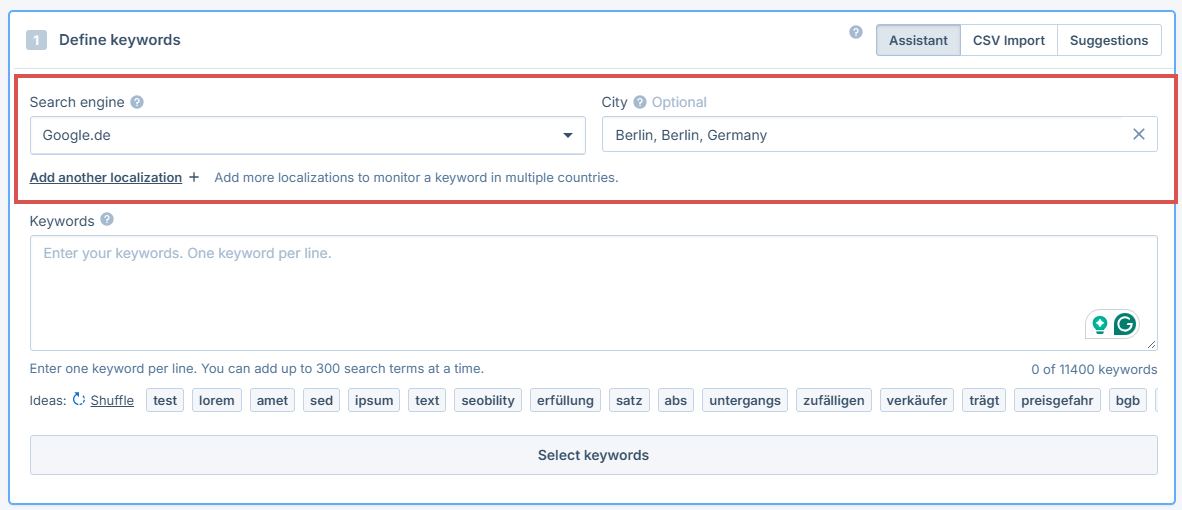
After this, you can add all the search terms you’d like to monitor.
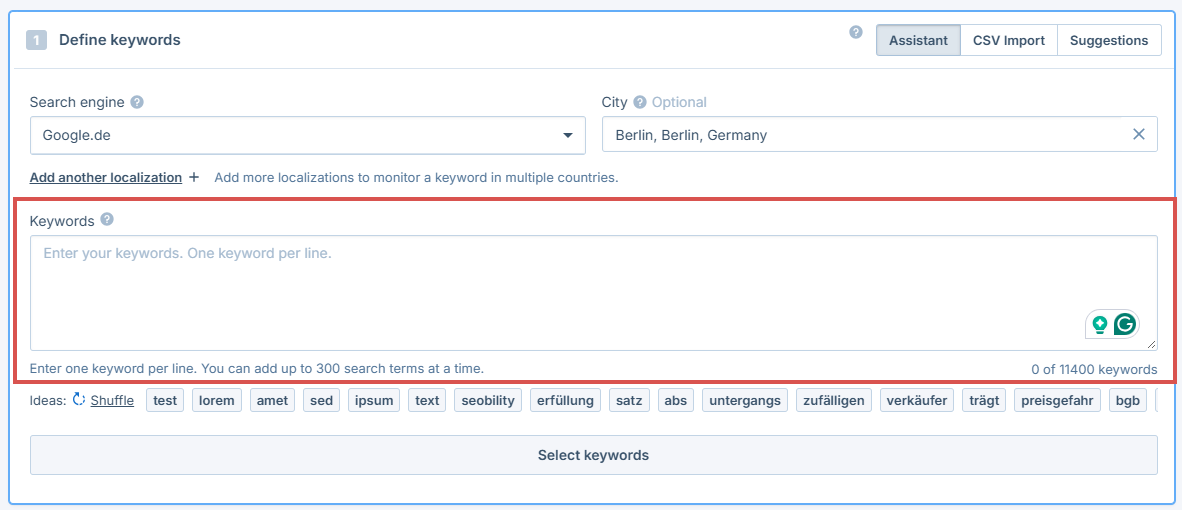
Seobility automatically calculates the search volume, competition level, and CPC and starts tracking your positions for each keyword:

The dashboard updates daily, and you can come back frequently to see how your rankings have changed and if any improvements are necessary. You can always add new keywords by clicking on the “New keyword” button:
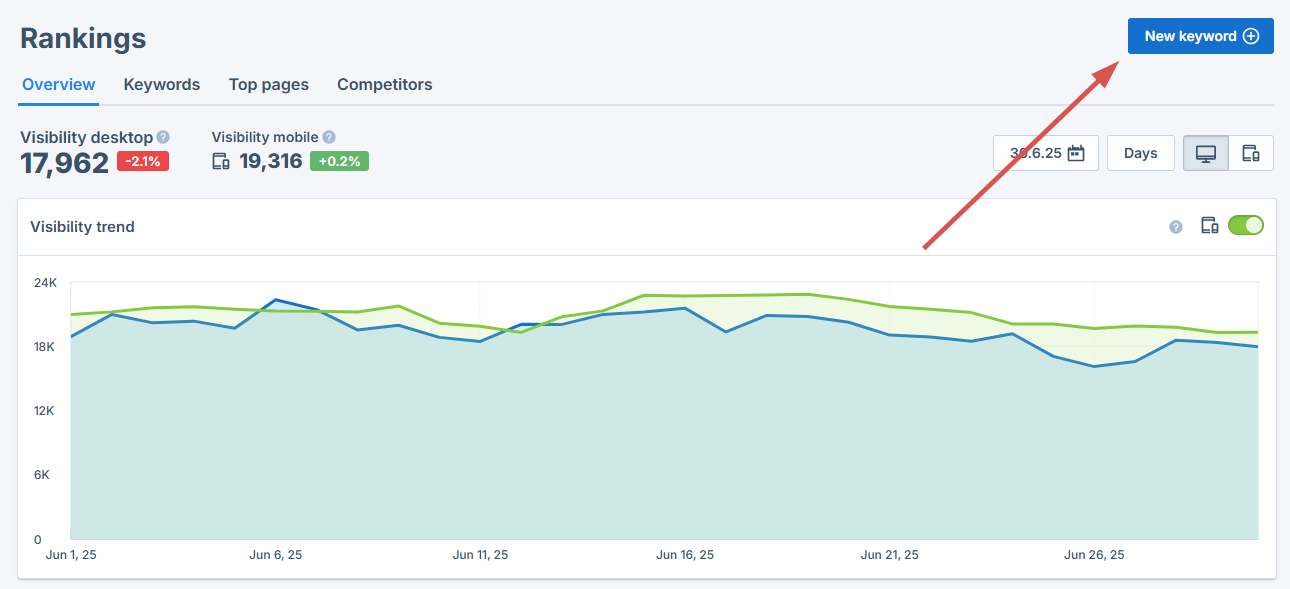
With the same tool, you can also track your Local Pack rankings. If you’re listed in the Local Pack for any of the search terms you’re monitoring, you’ll automatically see a small map icon next to your position:

The number indicates the Local Pack’s position in search results.
How to perform local keyword research for multiple locations
If you operate your business in multiple locations, we recommend performing keyword research for each location separately because search behaviors and SERP results vary for each location.
Start with your seed keywords and use Seobility’s Keyword Research Tool and Google Keyword Planner to find local keywords and search trends.
When you have the location-specific keywords, create separate pages for them. For example, if you run a fitness club in multiple cities, you can create a dedicated landing page for each location.
The gym chain below does exactly that by creating separate landing pages for each of its locations. They target the keyword “fitness club Zurich” with one of their landing pages:
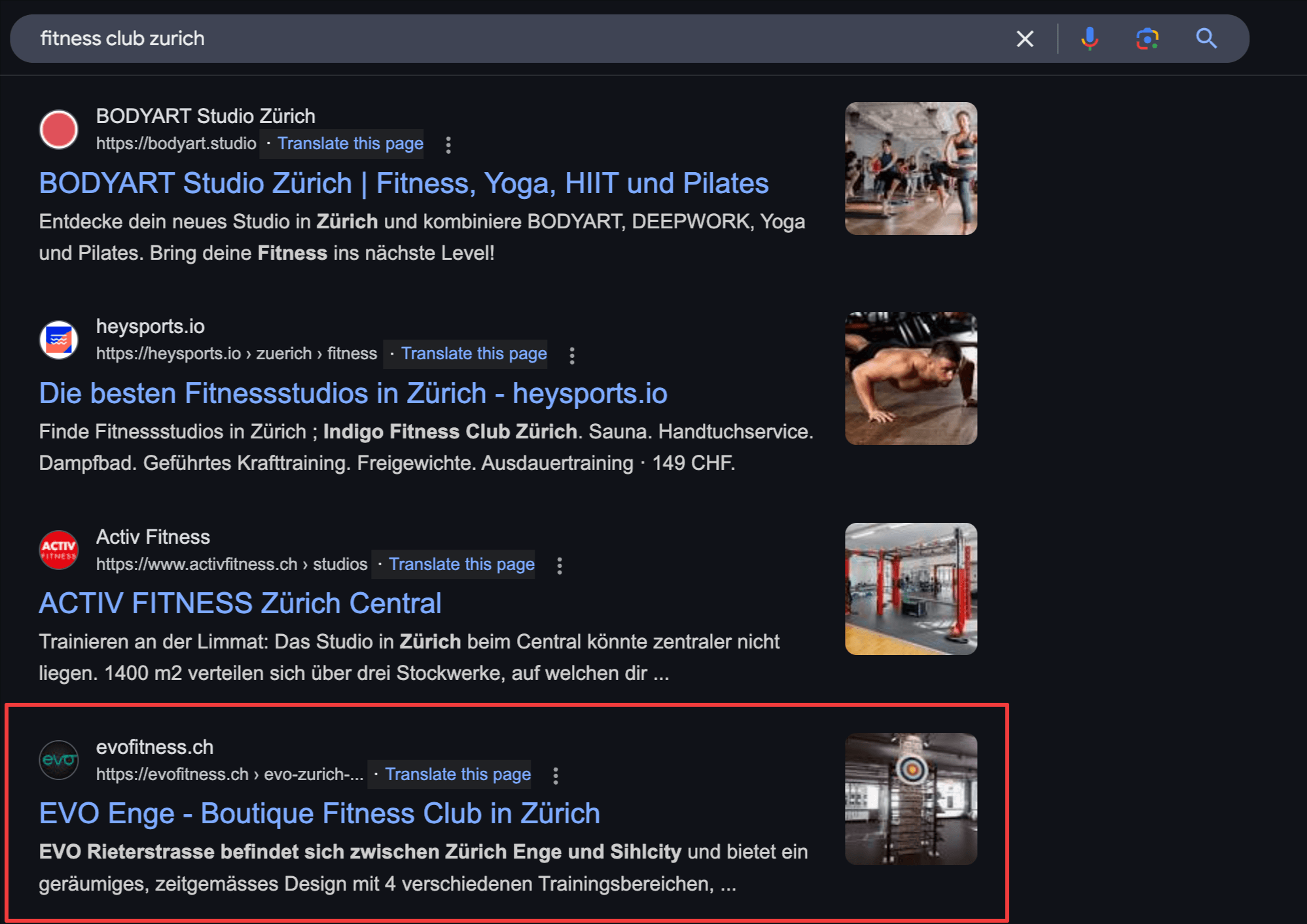
But note how they target the keyword “fitness club Luzern” with a different landing page:
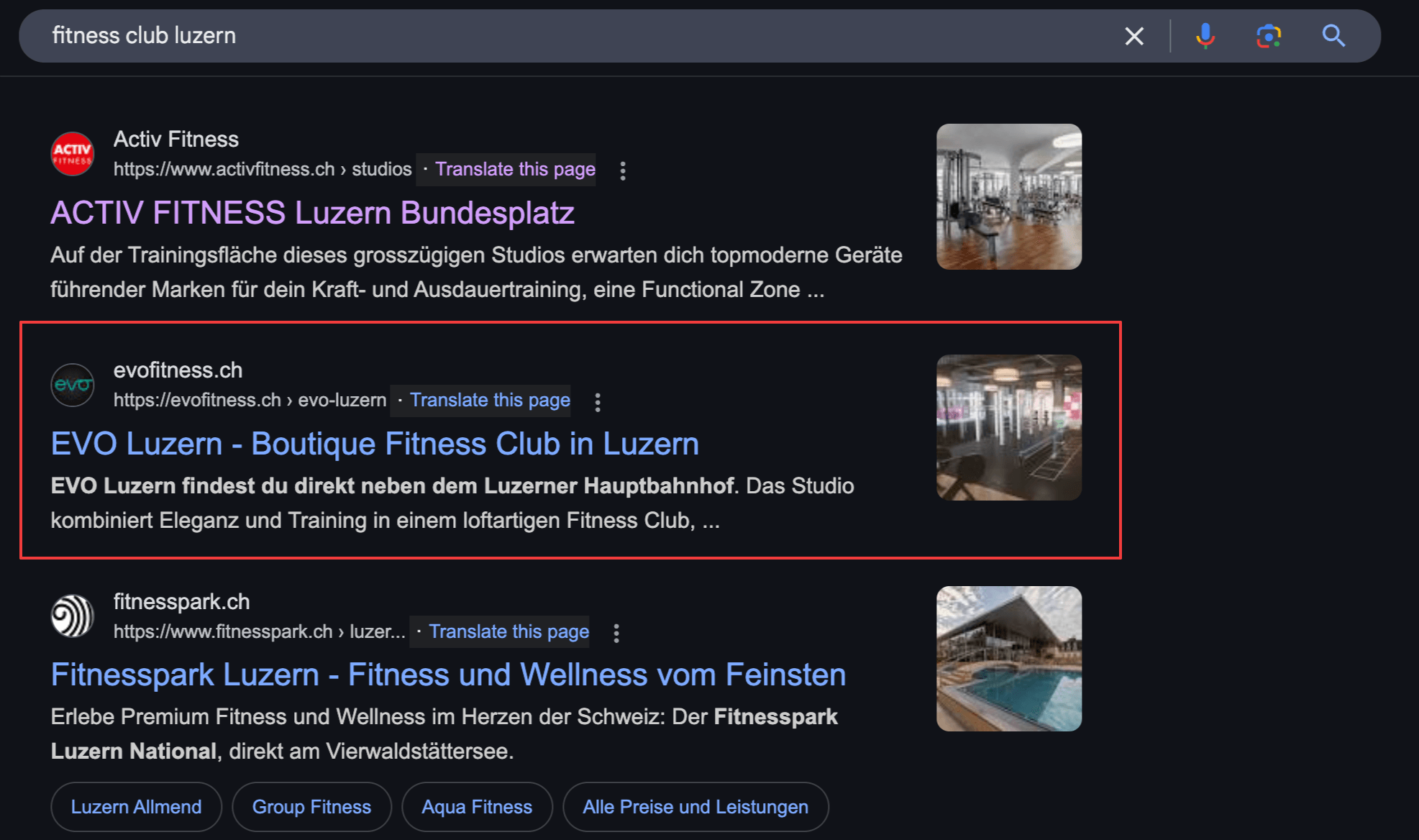
Creating separate pages for each location is also a smart way to keep customers informed about location-specific information, such as opening hours, special promotions, and contact information.
As you create these pages, make sure you create unique content for each location. Merely copying the same page and swapping out the location name can quickly lead to duplicate content issues.
How is AI search changing local SEO keyword research?
SEO is currently undergoing significant changes.
Google’s AI Overviews change the central position of the Local Pack for local searches, and at the same time, people are increasingly using platforms like ChatGPT to find local businesses.
This could affect local keyword research for two reasons:
1. Traditional keyword targeting may no longer guarantee visibility
With Google’s AI Overview taking so much of the space in the SERP (or even replacing the Local Pack entirely), top organic results might not drive the same traffic anymore.
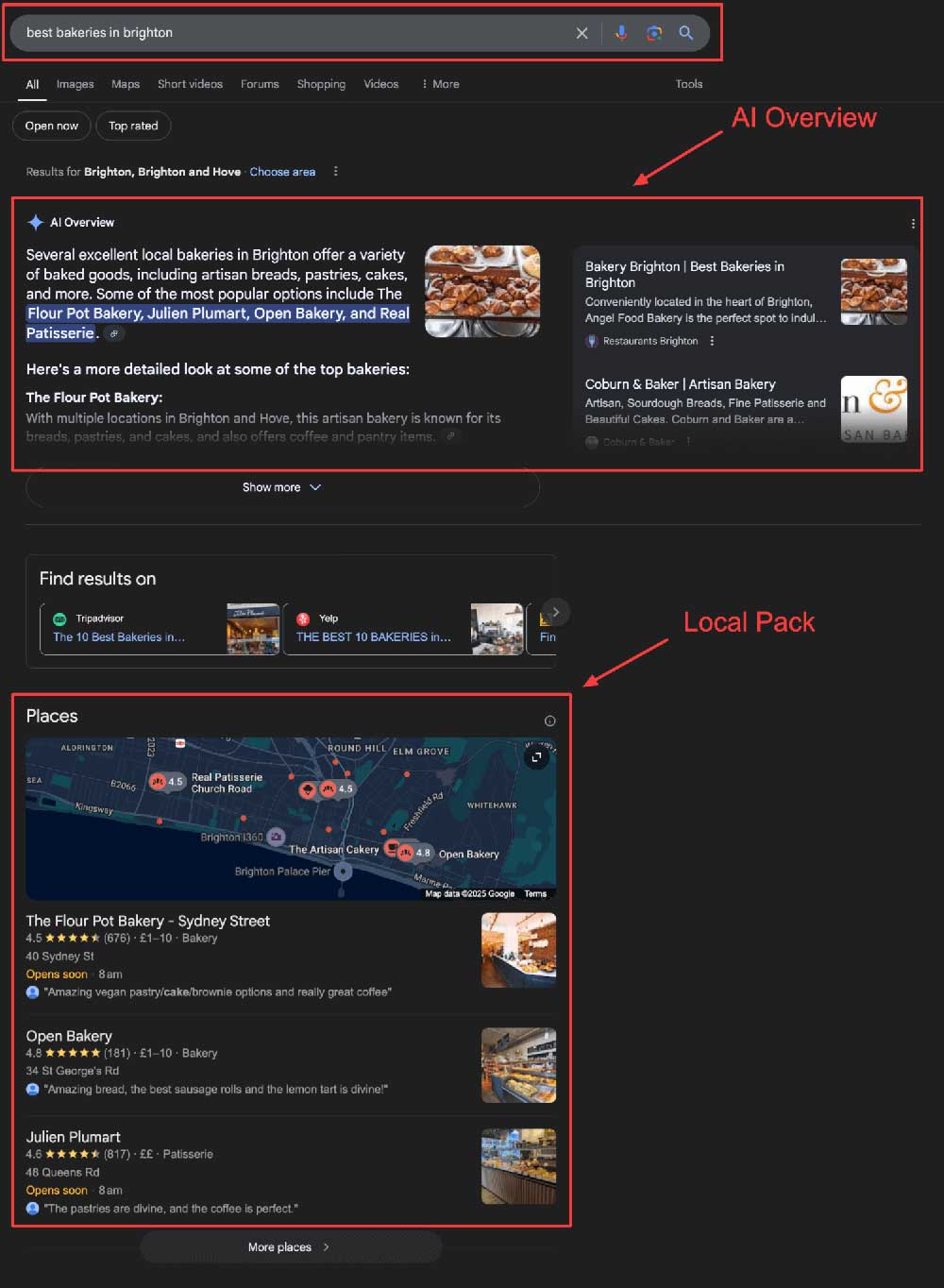
2. Users search differently across platforms
The way users search on Google significantly differs from how they search on AI chatbots, like ChatGPT.For example, AI searches are often more conversational than Google searches. A ChatGPT search could be, “Where can I get the best vegan lunch near me?” instead of “Best vegan restaurant near me.”
Tips on improving local SEO keyword research for AI results
My take on the recent SEO changes is that there is no reason to panic. If you’re already following the best practices for local SEO keyword research, you’re already a step ahead.
However, there are definitely things you can do to improve your local keyword research for AI results.
One great tip I heard on LinkedIn is to ask ChatGPT why your brand is/is not appearing for specific AI searches. This way, you can fine-tune your local keyword research strategy.
For example, if you’re operating a construction business in Austin, you could start the query by asking ChatGPT: “What are the best construction businesses in Austin?”
ChatGPT will give you a list of local businesses:
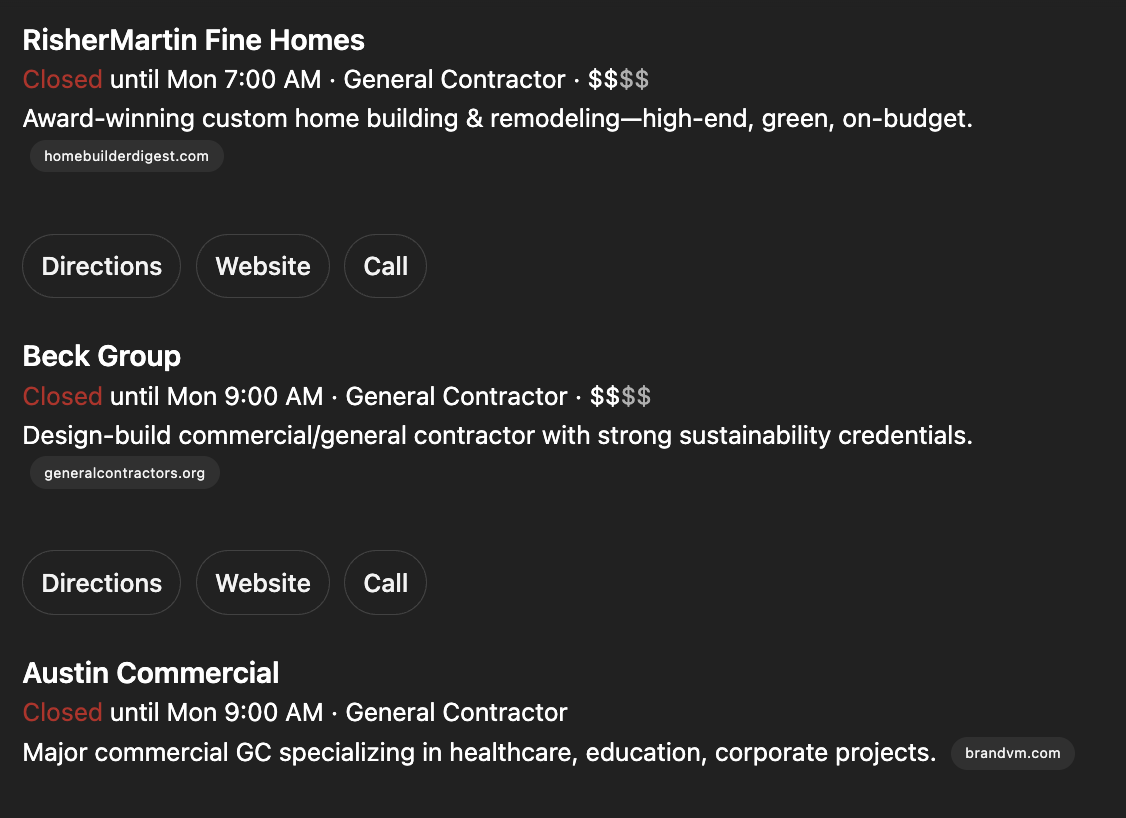
If your local business doesn’t appear in the list, you can ask ChatGPT questions about how you could improve your local keyword research to get better visibility in this specific search term.
This is how I asked ChatGPT further about this topic:

To these questions, ChatGPT gave us great recommendations of how it thinks we could improve our AI search visibility. Here’s a summary table it gave:
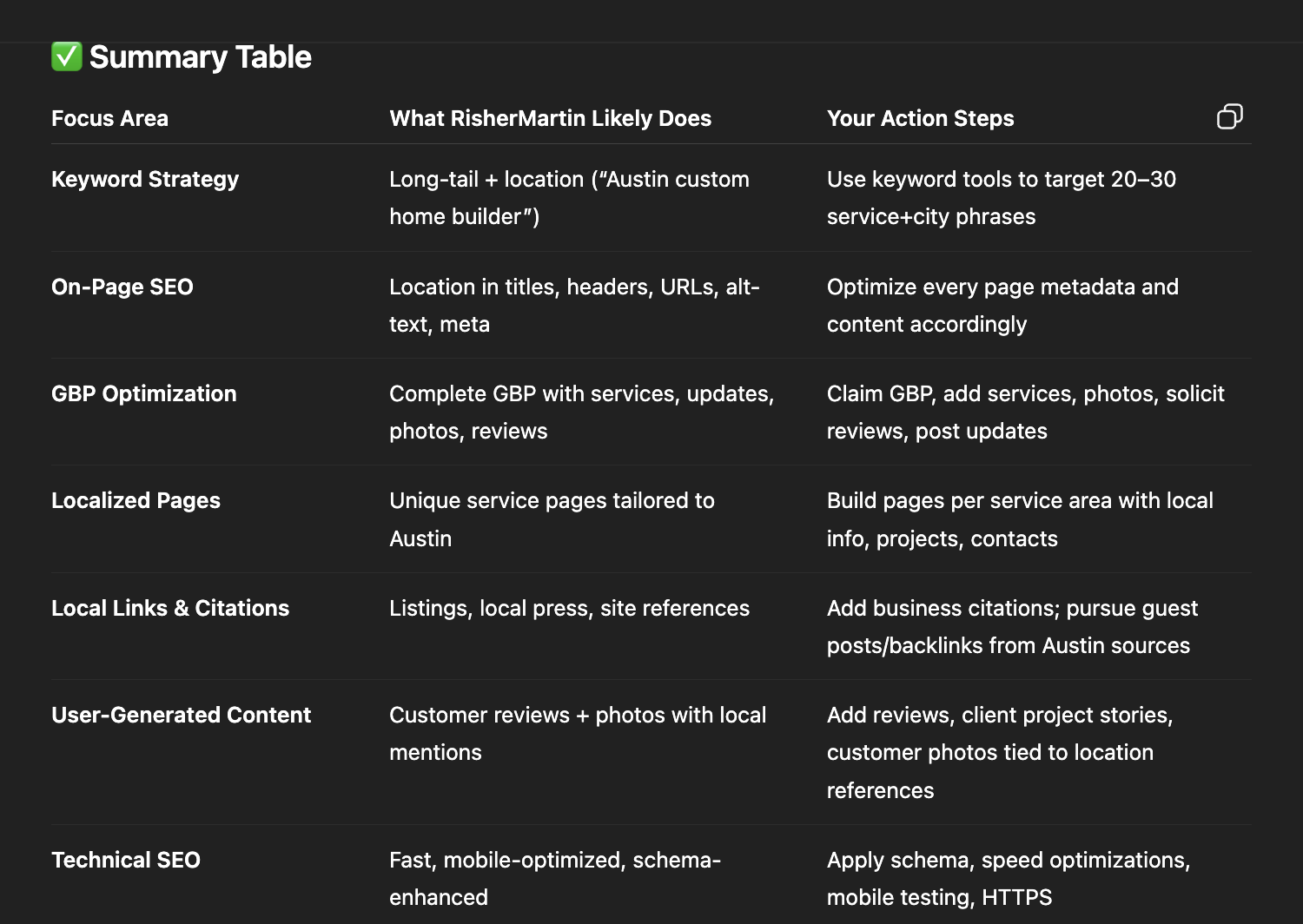
There are already great ideas here. Like with anything, though, take the responses with a grain of salt and avoid techniques like keyword stuffing.
And as ChatGPT says, keyword research isn’t the only reason businesses appear in AI search results. Other factors, like backlinks from local websites, reviews, and overall brand authority, play a significant role.
Another idea is to use tools like People Also Ask or Seobility’s Keyword Research tool to find question-based queries users are searching for.
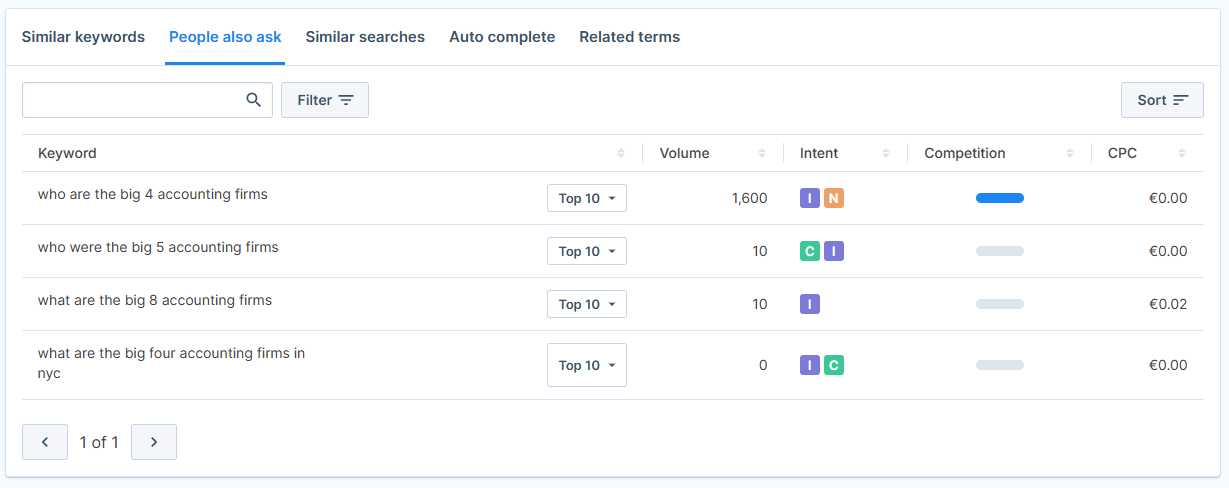
If there is enough search volume, you can create separate pages for these queries or add them as frequently asked questions (FAQs) in a pillar article. For example, if your page targets the keyword “plumber in Chicago”, you could add FAQs like “How much does a plumber charge in Chicago?” or “What plumbing services are available 24/7 in Chicago?”
By doing this, your queries might be picked up by Google’s AI Overview or AI chatbots, with a source link or a brand mention.
To conclude, the same local SEO keyword research strategies largely work in the “AI-based search era,” but as we described, there are always ways to improve your AI results. Because AI search is evolving so quickly, it’s difficult to predict what keyword research for local SEO will look like in a few years. However, we will update this article for you when new best practices emerge!
Conclusion
Statistics show that most consumers still use Google to find information about local businesses. This means that local SEO keyword research is more important than ever.
If you’re just starting out, it might feel overwhelming. However, the process gets easier with time. Plus, keyword research tools like Seobility simplify the process.
Signing up for Seobility’s Basic plan will let you perform five keyword checks per day for free, which will help with local keyword research. If you need to submit more queries each day, Seobility Premium allows you to submit up to 50 queries per day during its free 14-day trial period.
If this sounds like something you’d like to try, you can use Seobility’s free Keyword Research Tool on its website or sign up for a 14-day free trial.

